Analysis of Human Resource Management Practices of Sainsbury: Reward Management System and Employee Relations
VerifiedAdded on 2023/06/09
|21
|4674
|279
AI Summary
An analysis of the human resource management practices of Sainsbury with a focus on reward management system and employee relations. The content includes the internal and external analysis of the company, application of motivational theories, total reward system, performance-related pay, and analysis of the approach of Sainsbury in relation to employee relation.
Contribute Materials
Your contribution can guide someone’s learning journey. Share your
documents today.
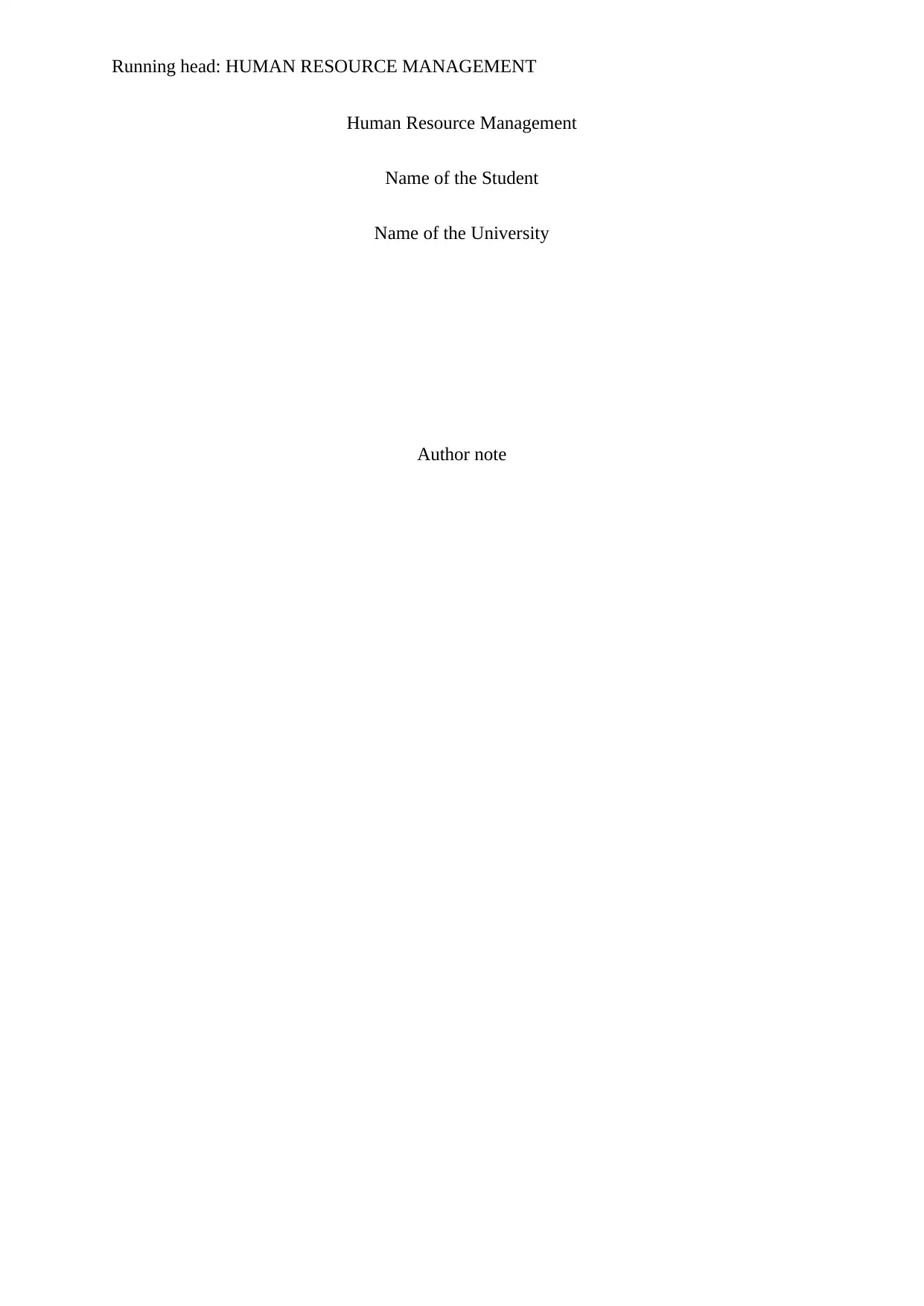
Running head: HUMAN RESOURCE MANAGEMENT
Human Resource Management
Name of the Student
Name of the University
Author note
Human Resource Management
Name of the Student
Name of the University
Author note
Secure Best Marks with AI Grader
Need help grading? Try our AI Grader for instant feedback on your assignments.
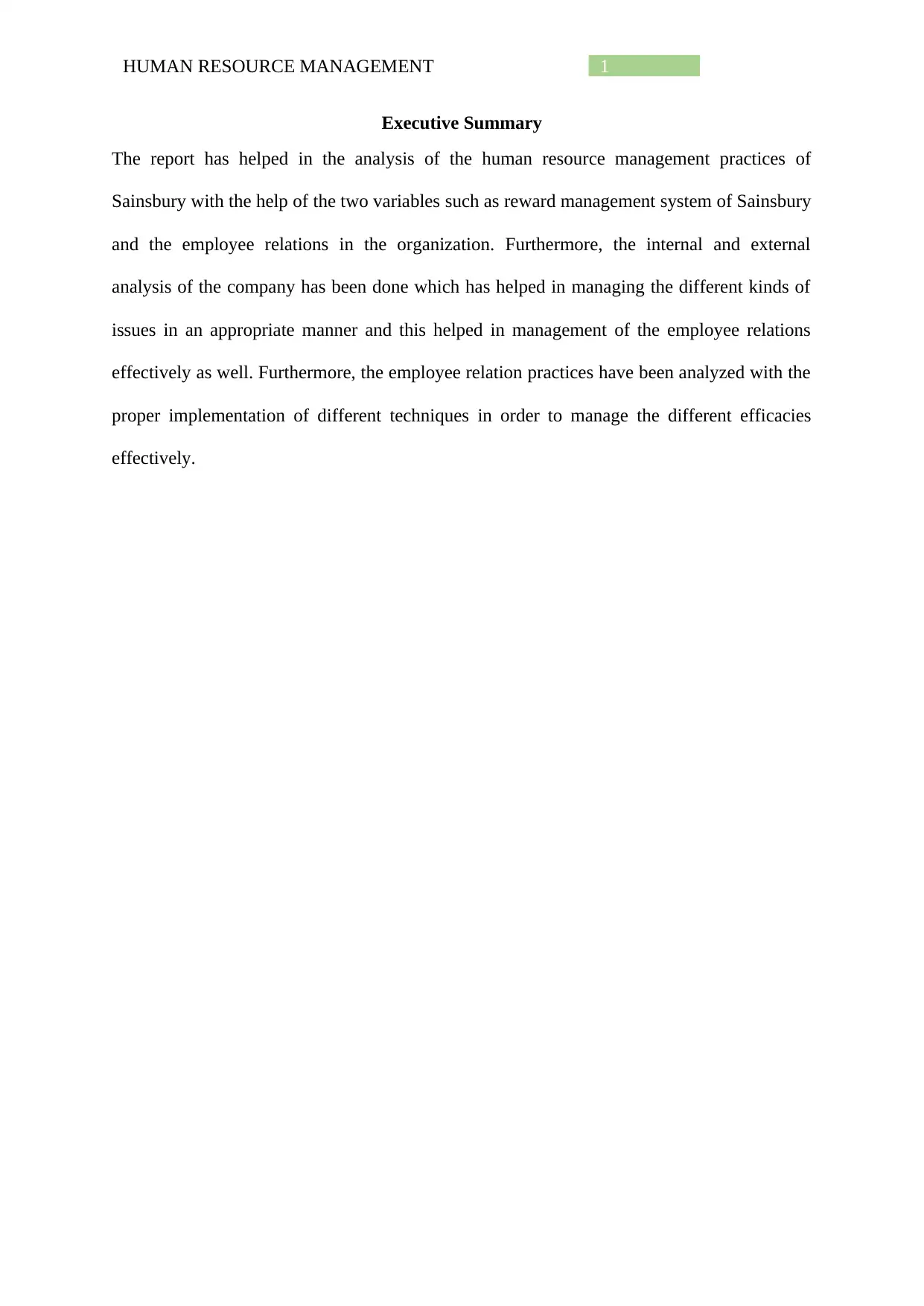
1HUMAN RESOURCE MANAGEMENT
Executive Summary
The report has helped in the analysis of the human resource management practices of
Sainsbury with the help of the two variables such as reward management system of Sainsbury
and the employee relations in the organization. Furthermore, the internal and external
analysis of the company has been done which has helped in managing the different kinds of
issues in an appropriate manner and this helped in management of the employee relations
effectively as well. Furthermore, the employee relation practices have been analyzed with the
proper implementation of different techniques in order to manage the different efficacies
effectively.
Executive Summary
The report has helped in the analysis of the human resource management practices of
Sainsbury with the help of the two variables such as reward management system of Sainsbury
and the employee relations in the organization. Furthermore, the internal and external
analysis of the company has been done which has helped in managing the different kinds of
issues in an appropriate manner and this helped in management of the employee relations
effectively as well. Furthermore, the employee relation practices have been analyzed with the
proper implementation of different techniques in order to manage the different efficacies
effectively.
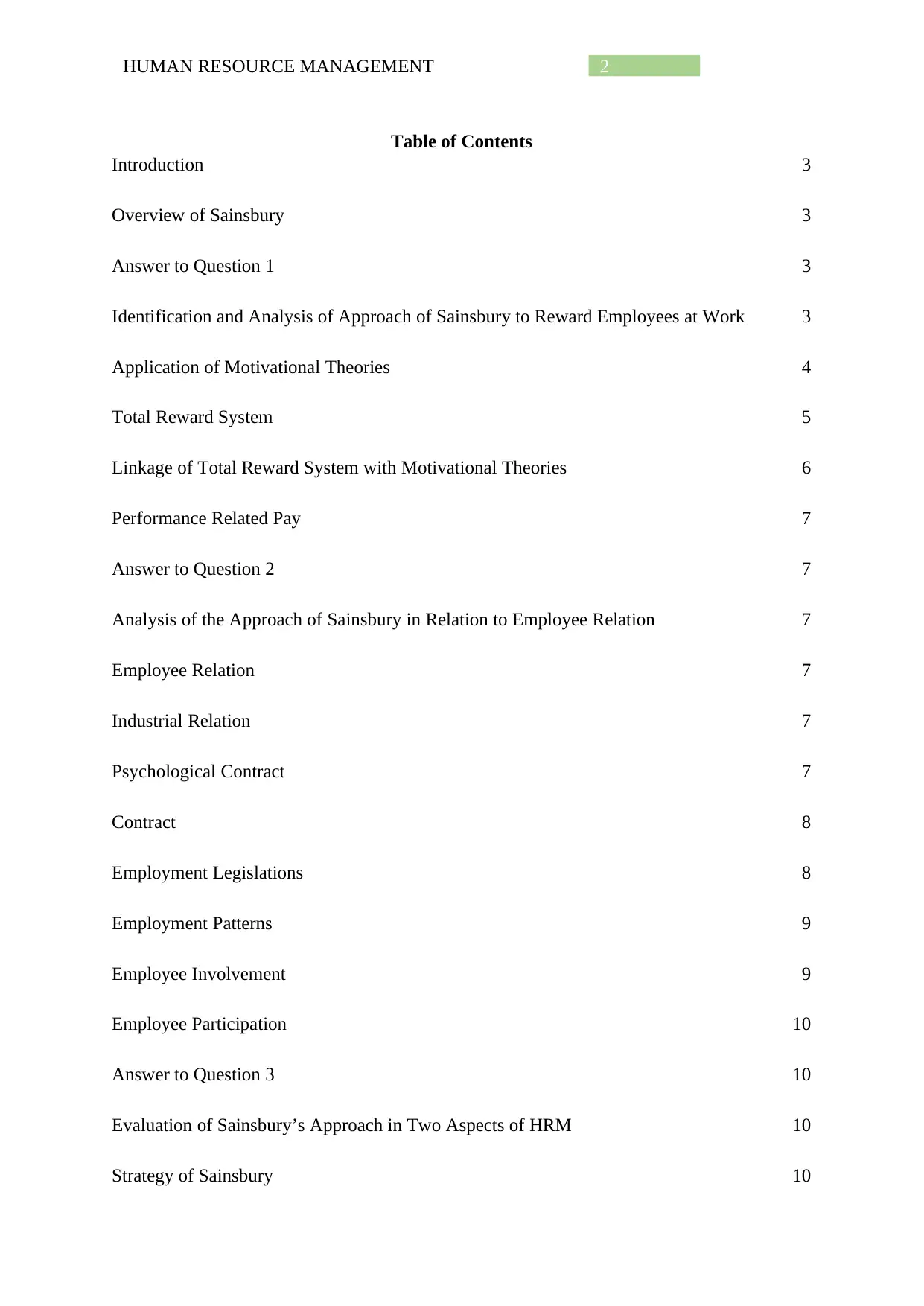
HUMAN RESOURCE MANAGEMENT 2
Table of Contents
Introduction 3
Overview of Sainsbury 3
Answer to Question 1 3
Identification and Analysis of Approach of Sainsbury to Reward Employees at Work 3
Application of Motivational Theories 4
Total Reward System 5
Linkage of Total Reward System with Motivational Theories 6
Performance Related Pay 7
Answer to Question 2 7
Analysis of the Approach of Sainsbury in Relation to Employee Relation 7
Employee Relation 7
Industrial Relation 7
Psychological Contract 7
Contract 8
Employment Legislations 8
Employment Patterns 9
Employee Involvement 9
Employee Participation 10
Answer to Question 3 10
Evaluation of Sainsbury’s Approach in Two Aspects of HRM 10
Strategy of Sainsbury 10
Table of Contents
Introduction 3
Overview of Sainsbury 3
Answer to Question 1 3
Identification and Analysis of Approach of Sainsbury to Reward Employees at Work 3
Application of Motivational Theories 4
Total Reward System 5
Linkage of Total Reward System with Motivational Theories 6
Performance Related Pay 7
Answer to Question 2 7
Analysis of the Approach of Sainsbury in Relation to Employee Relation 7
Employee Relation 7
Industrial Relation 7
Psychological Contract 7
Contract 8
Employment Legislations 8
Employment Patterns 9
Employee Involvement 9
Employee Participation 10
Answer to Question 3 10
Evaluation of Sainsbury’s Approach in Two Aspects of HRM 10
Strategy of Sainsbury 10

HUMAN RESOURCE MANAGEMENT 3
Evolution of HRM 11
PESTEL Analysis 11
SWOT Analysis 13
Porter’s Strategic Options 14
Cost Leadership 14
Differentiation 14
Workforce Planning 14
Conclusion 15
References 16
Evolution of HRM 11
PESTEL Analysis 11
SWOT Analysis 13
Porter’s Strategic Options 14
Cost Leadership 14
Differentiation 14
Workforce Planning 14
Conclusion 15
References 16
Secure Best Marks with AI Grader
Need help grading? Try our AI Grader for instant feedback on your assignments.

HUMAN RESOURCE MANAGEMENT 4
Introduction
The report helps in the analysis of approach of the respective company Sainsbury
wherein the approach of the company towards the rewarding employees in the organization
or at work. Furthermore, the analysis is done in order to understand the approach towards the
employee relations which is required to be conducted in an effective manner.
Overview of Sainsbury
Sainsbury is the second largest chain of the supermarkets in the United Kingdom with
more than 16.9% of the supermarket share in the entire sector. The Sainsbury is the public
limited company wherein the company is serving in different countries with more than 1415
stores around the world (Sainsburys.co.uk, 2018).
Answer to Question 1
Identification and Analysis of Approach of Sainsbury to Reward Employees at Work
There are different approaches which can be adopted by Sainsbury in managing and
regarding the different employees in the organization. Furthermore, this has been seen that
the employees are being rewarded with application of different methods such as:
● Pay- Cash Payment (Osituyo, Marnetand Dawson, 2017)
● Wages- Paid in cash to the different employees on a weekly basis
● Salary- Yearly Salary which can be provided to the employees in a weekly manner
It was seen and analysed that the reward plays an essential role in the motivation
provided to the different employees in the organization. In Sainsbury, it has been analysed
Introduction
The report helps in the analysis of approach of the respective company Sainsbury
wherein the approach of the company towards the rewarding employees in the organization
or at work. Furthermore, the analysis is done in order to understand the approach towards the
employee relations which is required to be conducted in an effective manner.
Overview of Sainsbury
Sainsbury is the second largest chain of the supermarkets in the United Kingdom with
more than 16.9% of the supermarket share in the entire sector. The Sainsbury is the public
limited company wherein the company is serving in different countries with more than 1415
stores around the world (Sainsburys.co.uk, 2018).
Answer to Question 1
Identification and Analysis of Approach of Sainsbury to Reward Employees at Work
There are different approaches which can be adopted by Sainsbury in managing and
regarding the different employees in the organization. Furthermore, this has been seen that
the employees are being rewarded with application of different methods such as:
● Pay- Cash Payment (Osituyo, Marnetand Dawson, 2017)
● Wages- Paid in cash to the different employees on a weekly basis
● Salary- Yearly Salary which can be provided to the employees in a weekly manner
It was seen and analysed that the reward plays an essential role in the motivation
provided to the different employees in the organization. In Sainsbury, it has been analysed
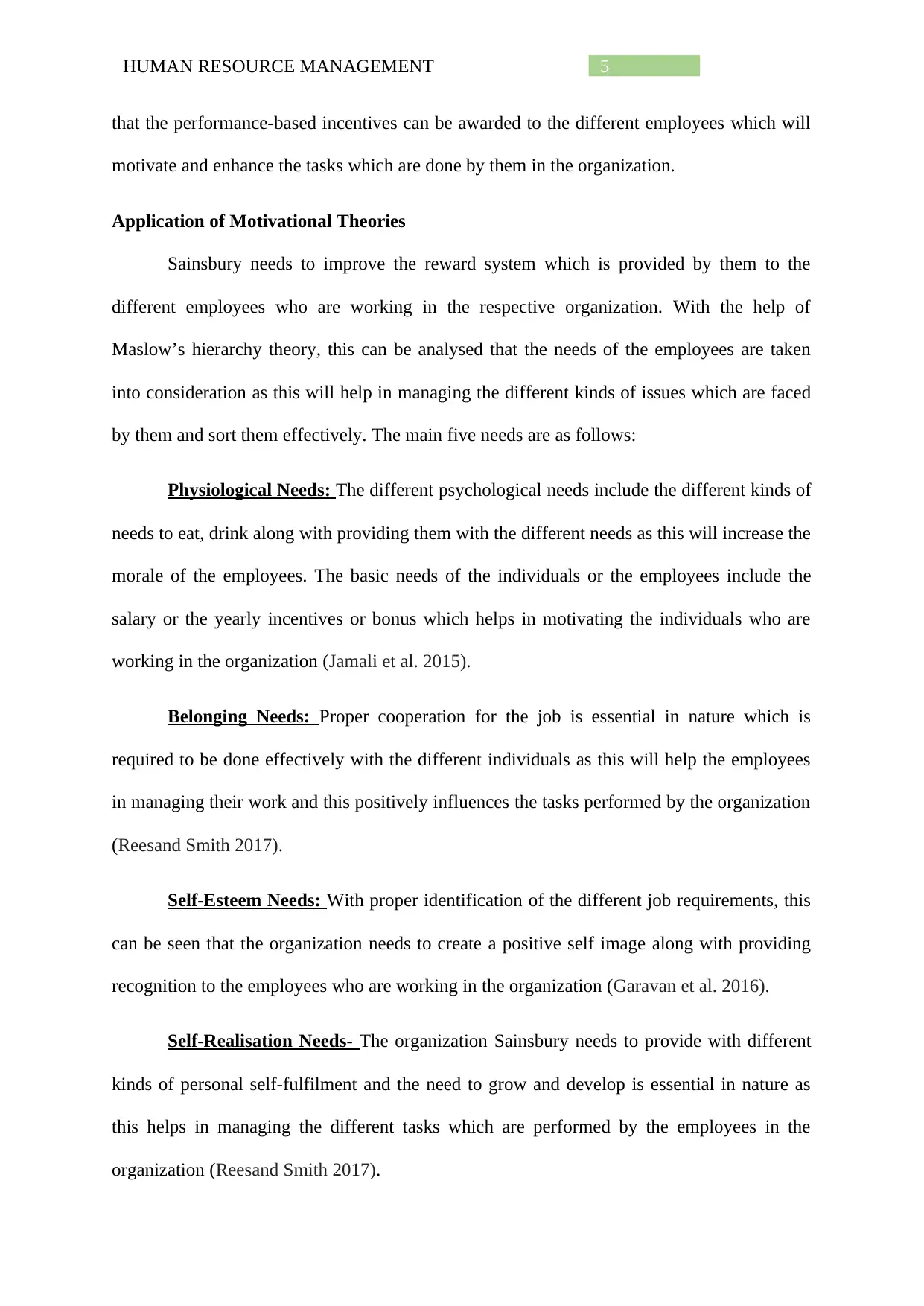
HUMAN RESOURCE MANAGEMENT 5
that the performance-based incentives can be awarded to the different employees which will
motivate and enhance the tasks which are done by them in the organization.
Application of Motivational Theories
Sainsbury needs to improve the reward system which is provided by them to the
different employees who are working in the respective organization. With the help of
Maslow’s hierarchy theory, this can be analysed that the needs of the employees are taken
into consideration as this will help in managing the different kinds of issues which are faced
by them and sort them effectively. The main five needs are as follows:
Physiological Needs: The different psychological needs include the different kinds of
needs to eat, drink along with providing them with the different needs as this will increase the
morale of the employees. The basic needs of the individuals or the employees include the
salary or the yearly incentives or bonus which helps in motivating the individuals who are
working in the organization (Jamali et al. 2015).
Belonging Needs: Proper cooperation for the job is essential in nature which is
required to be done effectively with the different individuals as this will help the employees
in managing their work and this positively influences the tasks performed by the organization
(Reesand Smith 2017).
Self-Esteem Needs: With proper identification of the different job requirements, this
can be seen that the organization needs to create a positive self image along with providing
recognition to the employees who are working in the organization (Garavan et al. 2016).
Self-Realisation Needs- The organization Sainsbury needs to provide with different
kinds of personal self-fulfilment and the need to grow and develop is essential in nature as
this helps in managing the different tasks which are performed by the employees in the
organization (Reesand Smith 2017).
that the performance-based incentives can be awarded to the different employees which will
motivate and enhance the tasks which are done by them in the organization.
Application of Motivational Theories
Sainsbury needs to improve the reward system which is provided by them to the
different employees who are working in the respective organization. With the help of
Maslow’s hierarchy theory, this can be analysed that the needs of the employees are taken
into consideration as this will help in managing the different kinds of issues which are faced
by them and sort them effectively. The main five needs are as follows:
Physiological Needs: The different psychological needs include the different kinds of
needs to eat, drink along with providing them with the different needs as this will increase the
morale of the employees. The basic needs of the individuals or the employees include the
salary or the yearly incentives or bonus which helps in motivating the individuals who are
working in the organization (Jamali et al. 2015).
Belonging Needs: Proper cooperation for the job is essential in nature which is
required to be done effectively with the different individuals as this will help the employees
in managing their work and this positively influences the tasks performed by the organization
(Reesand Smith 2017).
Self-Esteem Needs: With proper identification of the different job requirements, this
can be seen that the organization needs to create a positive self image along with providing
recognition to the employees who are working in the organization (Garavan et al. 2016).
Self-Realisation Needs- The organization Sainsbury needs to provide with different
kinds of personal self-fulfilment and the need to grow and develop is essential in nature as
this helps in managing the different tasks which are performed by the employees in the
organization (Reesand Smith 2017).
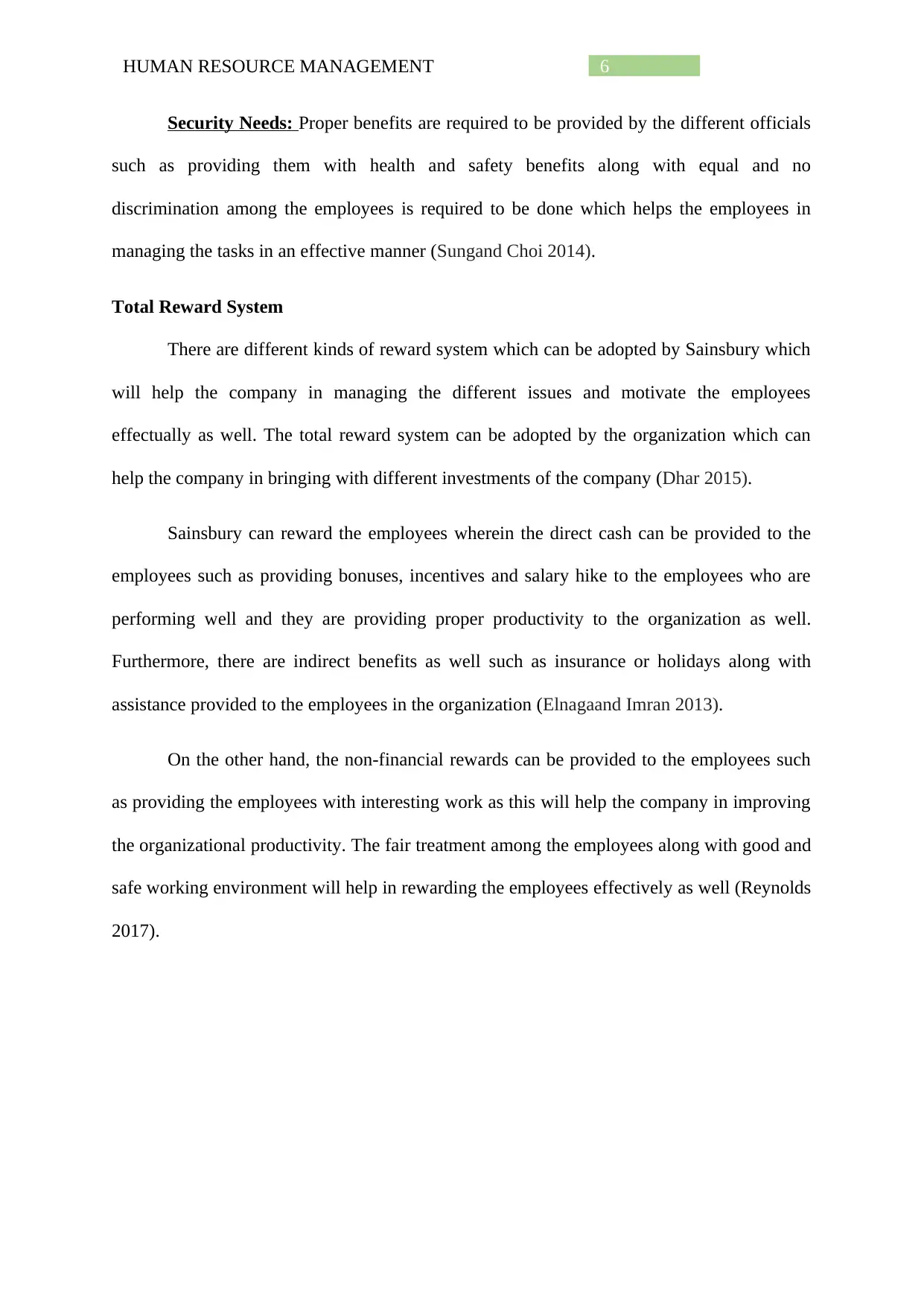
HUMAN RESOURCE MANAGEMENT 6
Security Needs: Proper benefits are required to be provided by the different officials
such as providing them with health and safety benefits along with equal and no
discrimination among the employees is required to be done which helps the employees in
managing the tasks in an effective manner (Sungand Choi 2014).
Total Reward System
There are different kinds of reward system which can be adopted by Sainsbury which
will help the company in managing the different issues and motivate the employees
effectually as well. The total reward system can be adopted by the organization which can
help the company in bringing with different investments of the company (Dhar 2015).
Sainsbury can reward the employees wherein the direct cash can be provided to the
employees such as providing bonuses, incentives and salary hike to the employees who are
performing well and they are providing proper productivity to the organization as well.
Furthermore, there are indirect benefits as well such as insurance or holidays along with
assistance provided to the employees in the organization (Elnagaand Imran 2013).
On the other hand, the non-financial rewards can be provided to the employees such
as providing the employees with interesting work as this will help the company in improving
the organizational productivity. The fair treatment among the employees along with good and
safe working environment will help in rewarding the employees effectively as well (Reynolds
2017).
Security Needs: Proper benefits are required to be provided by the different officials
such as providing them with health and safety benefits along with equal and no
discrimination among the employees is required to be done which helps the employees in
managing the tasks in an effective manner (Sungand Choi 2014).
Total Reward System
There are different kinds of reward system which can be adopted by Sainsbury which
will help the company in managing the different issues and motivate the employees
effectually as well. The total reward system can be adopted by the organization which can
help the company in bringing with different investments of the company (Dhar 2015).
Sainsbury can reward the employees wherein the direct cash can be provided to the
employees such as providing bonuses, incentives and salary hike to the employees who are
performing well and they are providing proper productivity to the organization as well.
Furthermore, there are indirect benefits as well such as insurance or holidays along with
assistance provided to the employees in the organization (Elnagaand Imran 2013).
On the other hand, the non-financial rewards can be provided to the employees such
as providing the employees with interesting work as this will help the company in improving
the organizational productivity. The fair treatment among the employees along with good and
safe working environment will help in rewarding the employees effectively as well (Reynolds
2017).
Paraphrase This Document
Need a fresh take? Get an instant paraphrase of this document with our AI Paraphraser
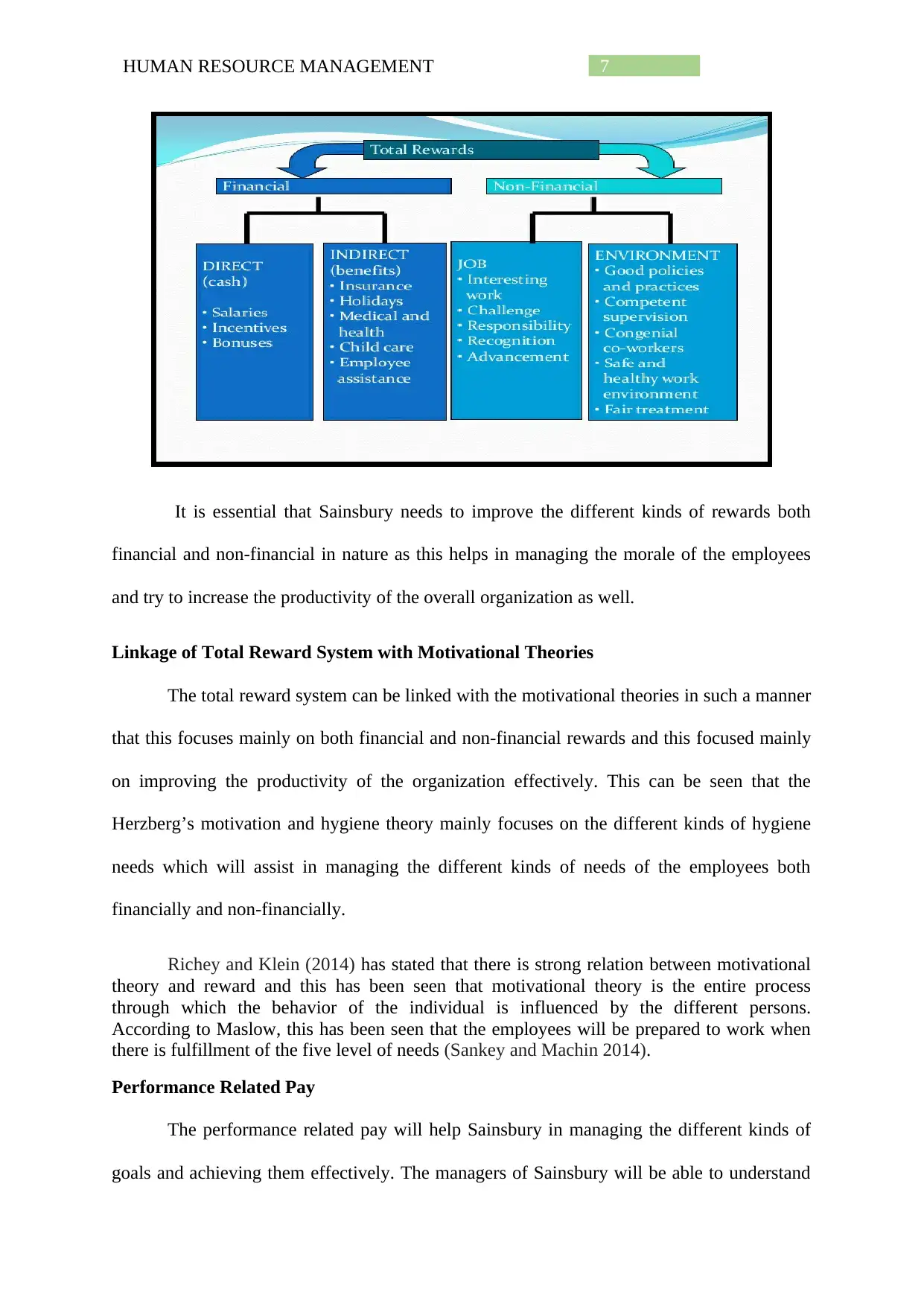
HUMAN RESOURCE MANAGEMENT 7
It is essential that Sainsbury needs to improve the different kinds of rewards both
financial and non-financial in nature as this helps in managing the morale of the employees
and try to increase the productivity of the overall organization as well.
Linkage of Total Reward System with Motivational Theories
The total reward system can be linked with the motivational theories in such a manner
that this focuses mainly on both financial and non-financial rewards and this focused mainly
on improving the productivity of the organization effectively. This can be seen that the
Herzberg’s motivation and hygiene theory mainly focuses on the different kinds of hygiene
needs which will assist in managing the different kinds of needs of the employees both
financially and non-financially.
Richey and Klein (2014) has stated that there is strong relation between motivational
theory and reward and this has been seen that motivational theory is the entire process
through which the behavior of the individual is influenced by the different persons.
According to Maslow, this has been seen that the employees will be prepared to work when
there is fulfillment of the five level of needs (Sankey and Machin 2014).
Performance Related Pay
The performance related pay will help Sainsbury in managing the different kinds of
goals and achieving them effectively. The managers of Sainsbury will be able to understand
It is essential that Sainsbury needs to improve the different kinds of rewards both
financial and non-financial in nature as this helps in managing the morale of the employees
and try to increase the productivity of the overall organization as well.
Linkage of Total Reward System with Motivational Theories
The total reward system can be linked with the motivational theories in such a manner
that this focuses mainly on both financial and non-financial rewards and this focused mainly
on improving the productivity of the organization effectively. This can be seen that the
Herzberg’s motivation and hygiene theory mainly focuses on the different kinds of hygiene
needs which will assist in managing the different kinds of needs of the employees both
financially and non-financially.
Richey and Klein (2014) has stated that there is strong relation between motivational
theory and reward and this has been seen that motivational theory is the entire process
through which the behavior of the individual is influenced by the different persons.
According to Maslow, this has been seen that the employees will be prepared to work when
there is fulfillment of the five level of needs (Sankey and Machin 2014).
Performance Related Pay
The performance related pay will help Sainsbury in managing the different kinds of
goals and achieving them effectively. The managers of Sainsbury will be able to understand
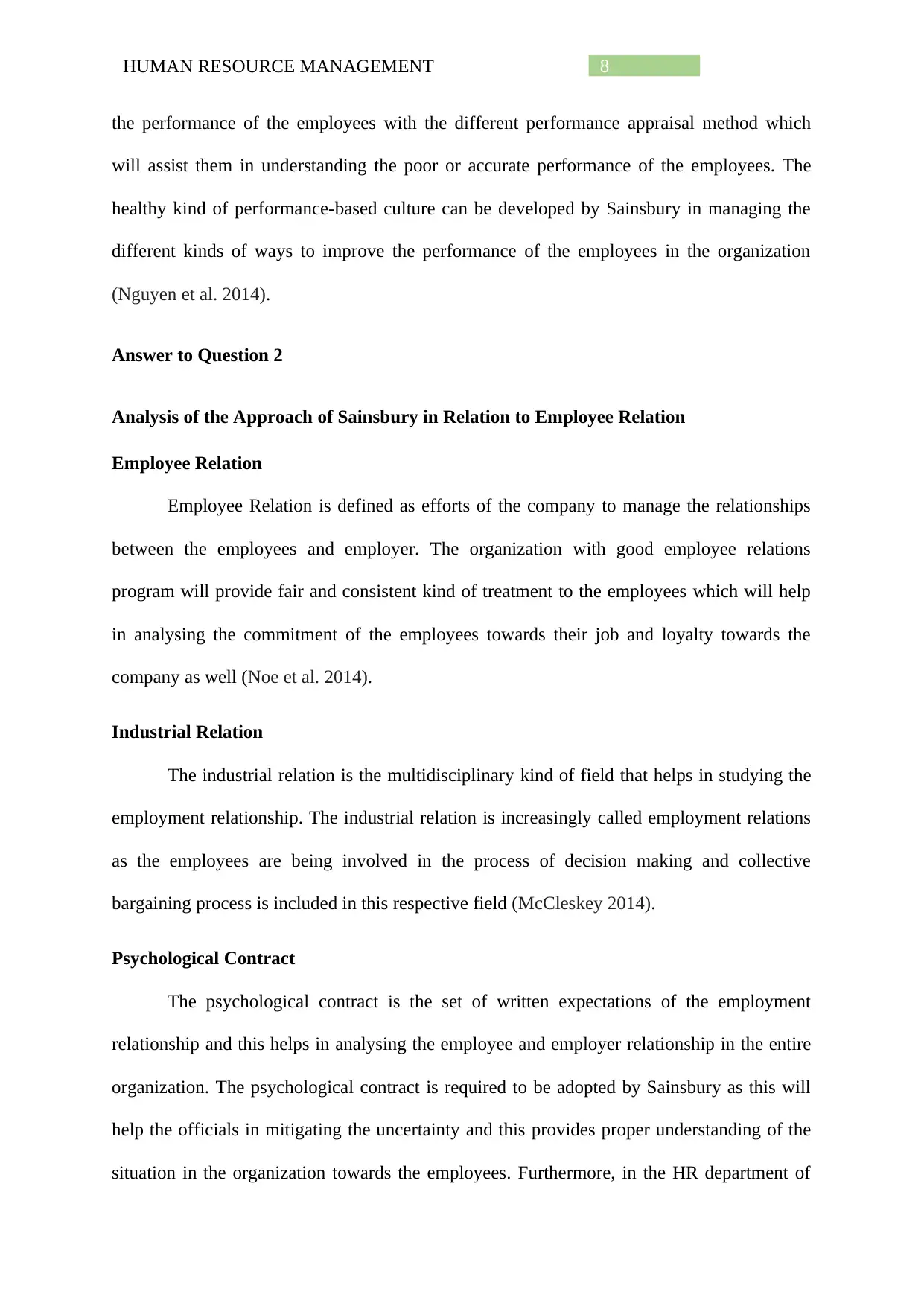
HUMAN RESOURCE MANAGEMENT 8
the performance of the employees with the different performance appraisal method which
will assist them in understanding the poor or accurate performance of the employees. The
healthy kind of performance-based culture can be developed by Sainsbury in managing the
different kinds of ways to improve the performance of the employees in the organization
(Nguyen et al. 2014).
Answer to Question 2
Analysis of the Approach of Sainsbury in Relation to Employee Relation
Employee Relation
Employee Relation is defined as efforts of the company to manage the relationships
between the employees and employer. The organization with good employee relations
program will provide fair and consistent kind of treatment to the employees which will help
in analysing the commitment of the employees towards their job and loyalty towards the
company as well (Noe et al. 2014).
Industrial Relation
The industrial relation is the multidisciplinary kind of field that helps in studying the
employment relationship. The industrial relation is increasingly called employment relations
as the employees are being involved in the process of decision making and collective
bargaining process is included in this respective field (McCleskey 2014).
Psychological Contract
The psychological contract is the set of written expectations of the employment
relationship and this helps in analysing the employee and employer relationship in the entire
organization. The psychological contract is required to be adopted by Sainsbury as this will
help the officials in mitigating the uncertainty and this provides proper understanding of the
situation in the organization towards the employees. Furthermore, in the HR department of
the performance of the employees with the different performance appraisal method which
will assist them in understanding the poor or accurate performance of the employees. The
healthy kind of performance-based culture can be developed by Sainsbury in managing the
different kinds of ways to improve the performance of the employees in the organization
(Nguyen et al. 2014).
Answer to Question 2
Analysis of the Approach of Sainsbury in Relation to Employee Relation
Employee Relation
Employee Relation is defined as efforts of the company to manage the relationships
between the employees and employer. The organization with good employee relations
program will provide fair and consistent kind of treatment to the employees which will help
in analysing the commitment of the employees towards their job and loyalty towards the
company as well (Noe et al. 2014).
Industrial Relation
The industrial relation is the multidisciplinary kind of field that helps in studying the
employment relationship. The industrial relation is increasingly called employment relations
as the employees are being involved in the process of decision making and collective
bargaining process is included in this respective field (McCleskey 2014).
Psychological Contract
The psychological contract is the set of written expectations of the employment
relationship and this helps in analysing the employee and employer relationship in the entire
organization. The psychological contract is required to be adopted by Sainsbury as this will
help the officials in mitigating the uncertainty and this provides proper understanding of the
situation in the organization towards the employees. Furthermore, in the HR department of
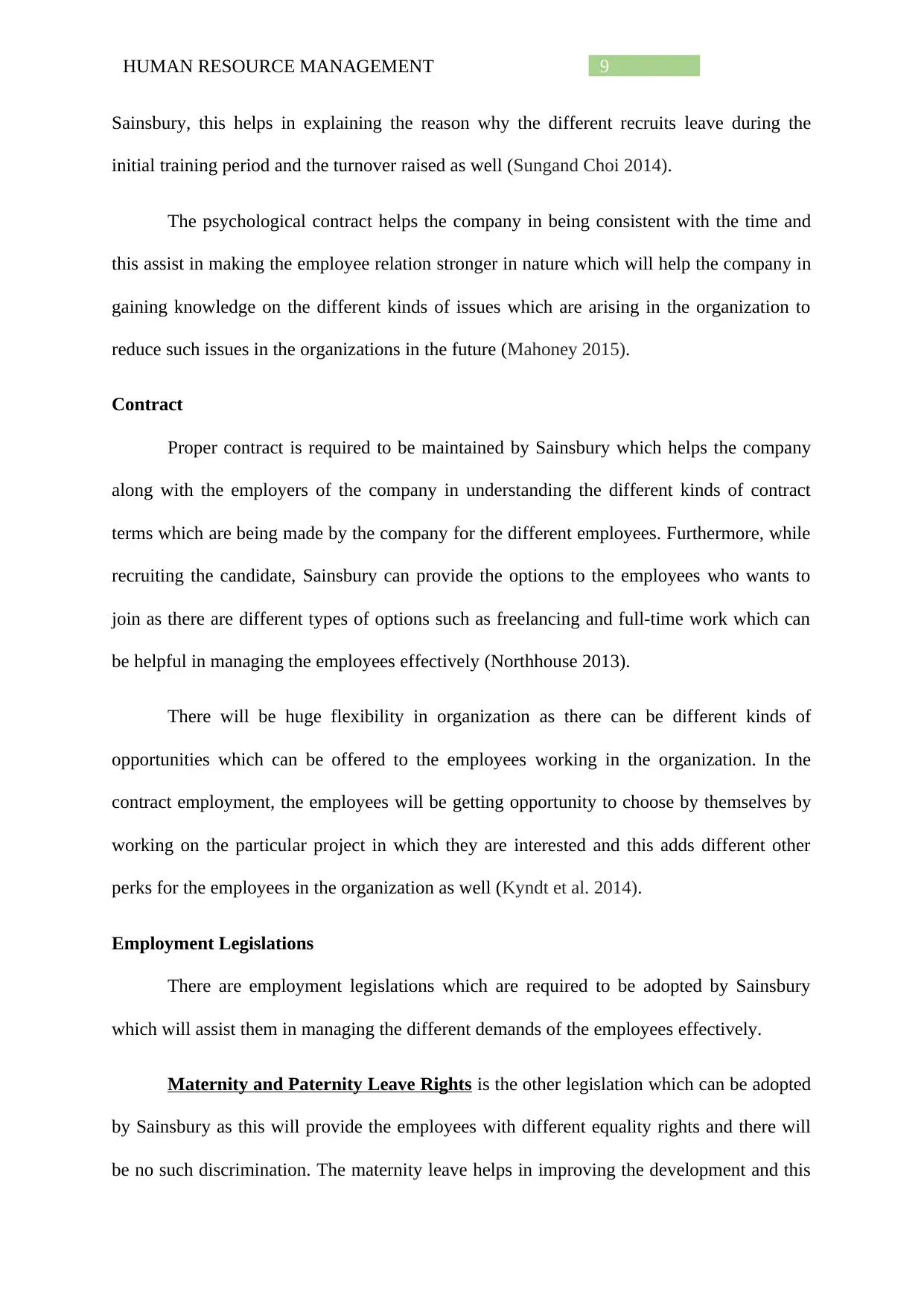
HUMAN RESOURCE MANAGEMENT 9
Sainsbury, this helps in explaining the reason why the different recruits leave during the
initial training period and the turnover raised as well (Sungand Choi 2014).
The psychological contract helps the company in being consistent with the time and
this assist in making the employee relation stronger in nature which will help the company in
gaining knowledge on the different kinds of issues which are arising in the organization to
reduce such issues in the organizations in the future (Mahoney 2015).
Contract
Proper contract is required to be maintained by Sainsbury which helps the company
along with the employers of the company in understanding the different kinds of contract
terms which are being made by the company for the different employees. Furthermore, while
recruiting the candidate, Sainsbury can provide the options to the employees who wants to
join as there are different types of options such as freelancing and full-time work which can
be helpful in managing the employees effectively (Northhouse 2013).
There will be huge flexibility in organization as there can be different kinds of
opportunities which can be offered to the employees working in the organization. In the
contract employment, the employees will be getting opportunity to choose by themselves by
working on the particular project in which they are interested and this adds different other
perks for the employees in the organization as well (Kyndt et al. 2014).
Employment Legislations
There are employment legislations which are required to be adopted by Sainsbury
which will assist them in managing the different demands of the employees effectively.
Maternity and Paternity Leave Rights is the other legislation which can be adopted
by Sainsbury as this will provide the employees with different equality rights and there will
be no such discrimination. The maternity leave helps in improving the development and this
Sainsbury, this helps in explaining the reason why the different recruits leave during the
initial training period and the turnover raised as well (Sungand Choi 2014).
The psychological contract helps the company in being consistent with the time and
this assist in making the employee relation stronger in nature which will help the company in
gaining knowledge on the different kinds of issues which are arising in the organization to
reduce such issues in the organizations in the future (Mahoney 2015).
Contract
Proper contract is required to be maintained by Sainsbury which helps the company
along with the employers of the company in understanding the different kinds of contract
terms which are being made by the company for the different employees. Furthermore, while
recruiting the candidate, Sainsbury can provide the options to the employees who wants to
join as there are different types of options such as freelancing and full-time work which can
be helpful in managing the employees effectively (Northhouse 2013).
There will be huge flexibility in organization as there can be different kinds of
opportunities which can be offered to the employees working in the organization. In the
contract employment, the employees will be getting opportunity to choose by themselves by
working on the particular project in which they are interested and this adds different other
perks for the employees in the organization as well (Kyndt et al. 2014).
Employment Legislations
There are employment legislations which are required to be adopted by Sainsbury
which will assist them in managing the different demands of the employees effectively.
Maternity and Paternity Leave Rights is the other legislation which can be adopted
by Sainsbury as this will provide the employees with different equality rights and there will
be no such discrimination. The maternity leave helps in improving the development and this
Secure Best Marks with AI Grader
Need help grading? Try our AI Grader for instant feedback on your assignments.
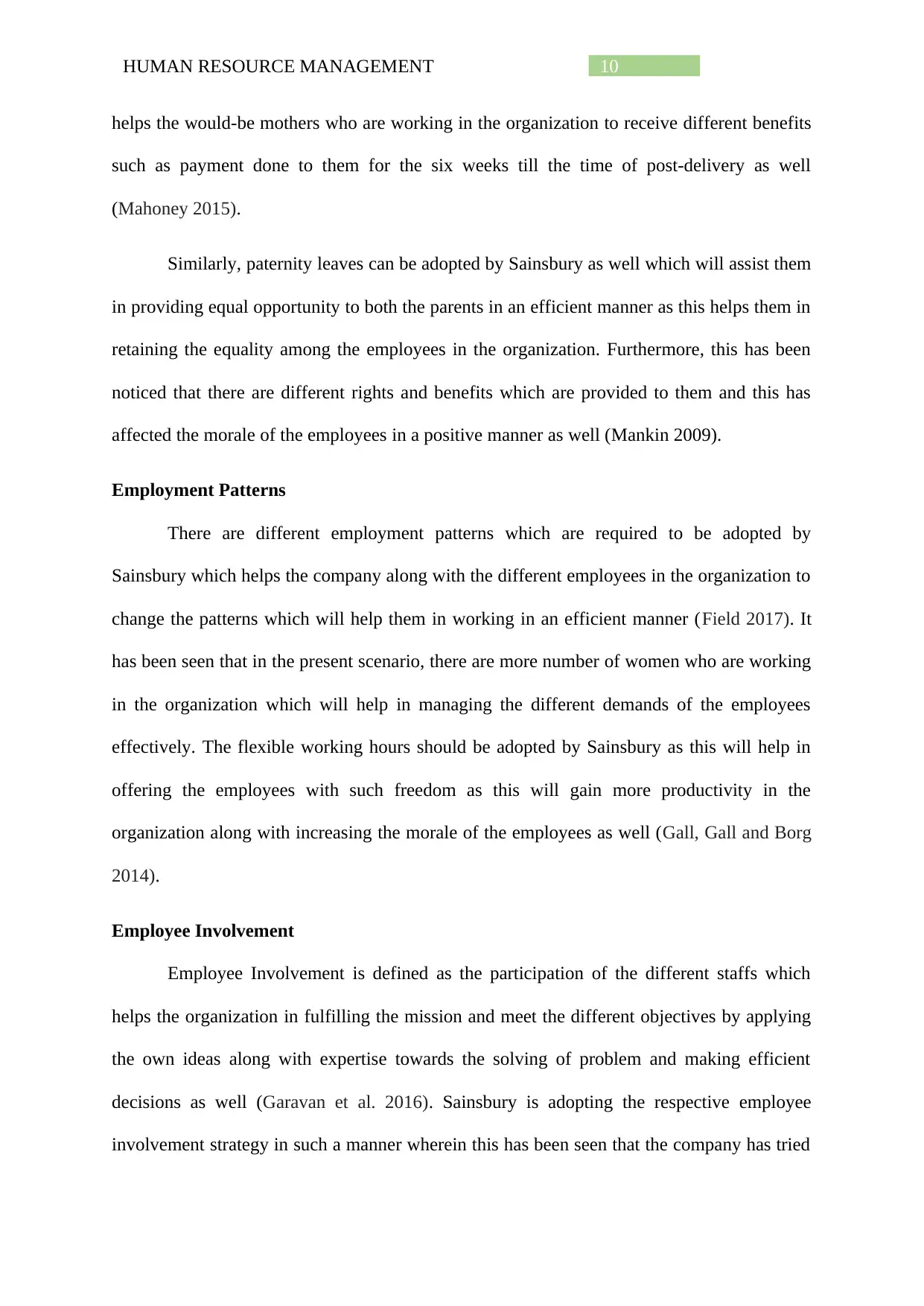
HUMAN RESOURCE MANAGEMENT 10
helps the would-be mothers who are working in the organization to receive different benefits
such as payment done to them for the six weeks till the time of post-delivery as well
(Mahoney 2015).
Similarly, paternity leaves can be adopted by Sainsbury as well which will assist them
in providing equal opportunity to both the parents in an efficient manner as this helps them in
retaining the equality among the employees in the organization. Furthermore, this has been
noticed that there are different rights and benefits which are provided to them and this has
affected the morale of the employees in a positive manner as well (Mankin 2009).
Employment Patterns
There are different employment patterns which are required to be adopted by
Sainsbury which helps the company along with the different employees in the organization to
change the patterns which will help them in working in an efficient manner (Field 2017). It
has been seen that in the present scenario, there are more number of women who are working
in the organization which will help in managing the different demands of the employees
effectively. The flexible working hours should be adopted by Sainsbury as this will help in
offering the employees with such freedom as this will gain more productivity in the
organization along with increasing the morale of the employees as well (Gall, Gall and Borg
2014).
Employee Involvement
Employee Involvement is defined as the participation of the different staffs which
helps the organization in fulfilling the mission and meet the different objectives by applying
the own ideas along with expertise towards the solving of problem and making efficient
decisions as well (Garavan et al. 2016). Sainsbury is adopting the respective employee
involvement strategy in such a manner wherein this has been seen that the company has tried
helps the would-be mothers who are working in the organization to receive different benefits
such as payment done to them for the six weeks till the time of post-delivery as well
(Mahoney 2015).
Similarly, paternity leaves can be adopted by Sainsbury as well which will assist them
in providing equal opportunity to both the parents in an efficient manner as this helps them in
retaining the equality among the employees in the organization. Furthermore, this has been
noticed that there are different rights and benefits which are provided to them and this has
affected the morale of the employees in a positive manner as well (Mankin 2009).
Employment Patterns
There are different employment patterns which are required to be adopted by
Sainsbury which helps the company along with the different employees in the organization to
change the patterns which will help them in working in an efficient manner (Field 2017). It
has been seen that in the present scenario, there are more number of women who are working
in the organization which will help in managing the different demands of the employees
effectively. The flexible working hours should be adopted by Sainsbury as this will help in
offering the employees with such freedom as this will gain more productivity in the
organization along with increasing the morale of the employees as well (Gall, Gall and Borg
2014).
Employee Involvement
Employee Involvement is defined as the participation of the different staffs which
helps the organization in fulfilling the mission and meet the different objectives by applying
the own ideas along with expertise towards the solving of problem and making efficient
decisions as well (Garavan et al. 2016). Sainsbury is adopting the respective employee
involvement strategy in such a manner wherein this has been seen that the company has tried
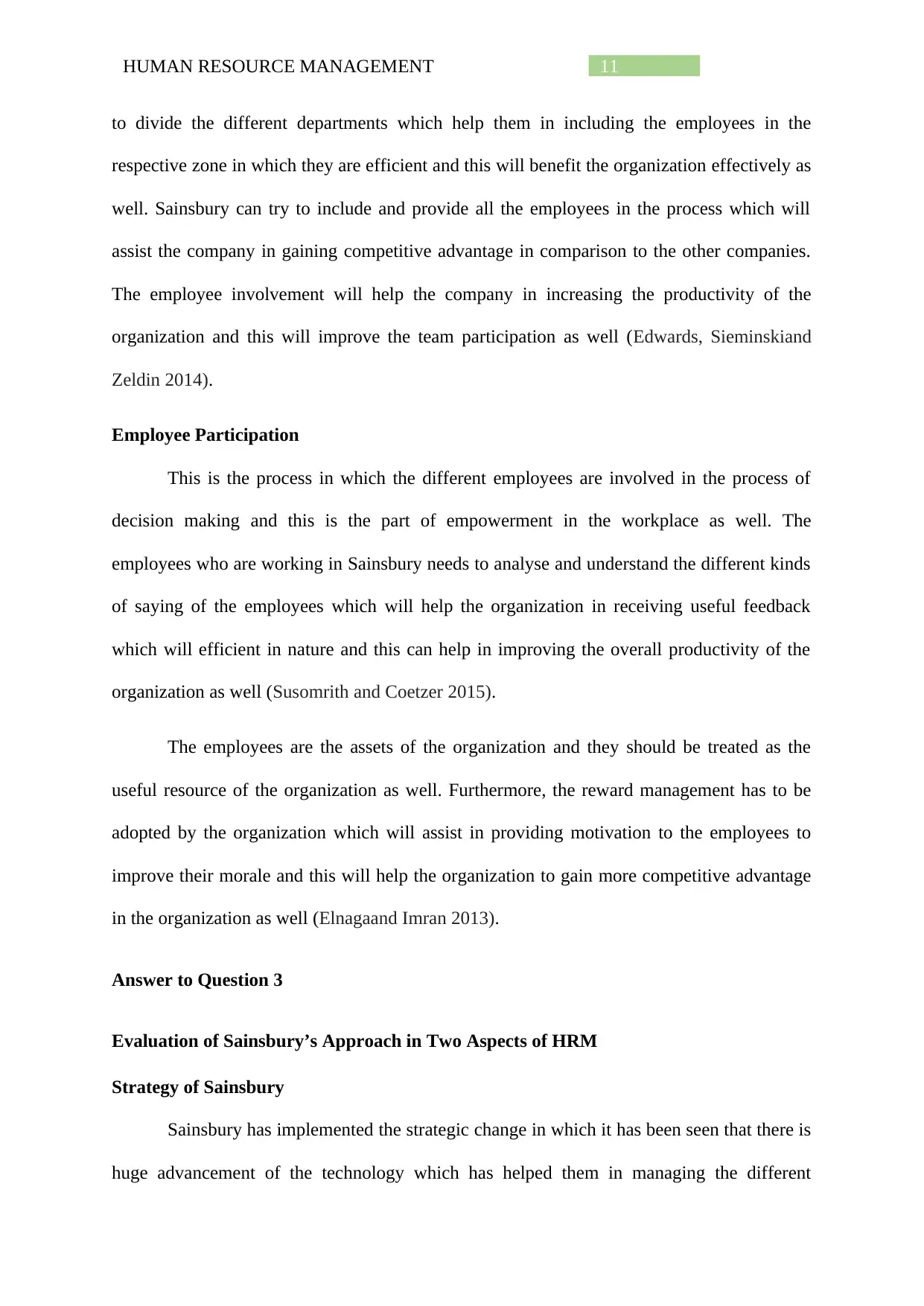
HUMAN RESOURCE MANAGEMENT 11
to divide the different departments which help them in including the employees in the
respective zone in which they are efficient and this will benefit the organization effectively as
well. Sainsbury can try to include and provide all the employees in the process which will
assist the company in gaining competitive advantage in comparison to the other companies.
The employee involvement will help the company in increasing the productivity of the
organization and this will improve the team participation as well (Edwards, Sieminskiand
Zeldin 2014).
Employee Participation
This is the process in which the different employees are involved in the process of
decision making and this is the part of empowerment in the workplace as well. The
employees who are working in Sainsbury needs to analyse and understand the different kinds
of saying of the employees which will help the organization in receiving useful feedback
which will efficient in nature and this can help in improving the overall productivity of the
organization as well (Susomrith and Coetzer 2015).
The employees are the assets of the organization and they should be treated as the
useful resource of the organization as well. Furthermore, the reward management has to be
adopted by the organization which will assist in providing motivation to the employees to
improve their morale and this will help the organization to gain more competitive advantage
in the organization as well (Elnagaand Imran 2013).
Answer to Question 3
Evaluation of Sainsbury’s Approach in Two Aspects of HRM
Strategy of Sainsbury
Sainsbury has implemented the strategic change in which it has been seen that there is
huge advancement of the technology which has helped them in managing the different
to divide the different departments which help them in including the employees in the
respective zone in which they are efficient and this will benefit the organization effectively as
well. Sainsbury can try to include and provide all the employees in the process which will
assist the company in gaining competitive advantage in comparison to the other companies.
The employee involvement will help the company in increasing the productivity of the
organization and this will improve the team participation as well (Edwards, Sieminskiand
Zeldin 2014).
Employee Participation
This is the process in which the different employees are involved in the process of
decision making and this is the part of empowerment in the workplace as well. The
employees who are working in Sainsbury needs to analyse and understand the different kinds
of saying of the employees which will help the organization in receiving useful feedback
which will efficient in nature and this can help in improving the overall productivity of the
organization as well (Susomrith and Coetzer 2015).
The employees are the assets of the organization and they should be treated as the
useful resource of the organization as well. Furthermore, the reward management has to be
adopted by the organization which will assist in providing motivation to the employees to
improve their morale and this will help the organization to gain more competitive advantage
in the organization as well (Elnagaand Imran 2013).
Answer to Question 3
Evaluation of Sainsbury’s Approach in Two Aspects of HRM
Strategy of Sainsbury
Sainsbury has implemented the strategic change in which it has been seen that there is
huge advancement of the technology which has helped them in managing the different
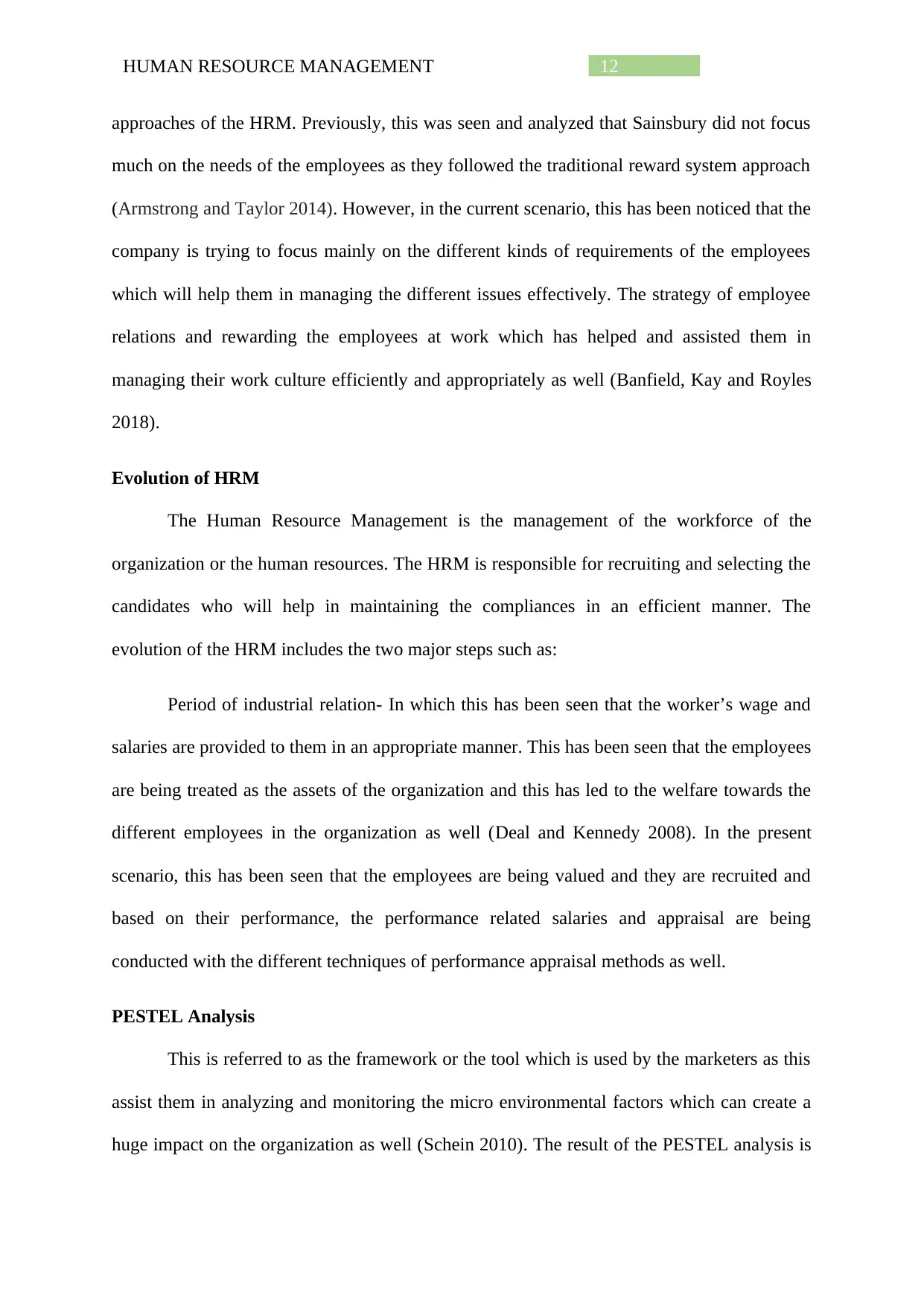
HUMAN RESOURCE MANAGEMENT 12
approaches of the HRM. Previously, this was seen and analyzed that Sainsbury did not focus
much on the needs of the employees as they followed the traditional reward system approach
(Armstrong and Taylor 2014). However, in the current scenario, this has been noticed that the
company is trying to focus mainly on the different kinds of requirements of the employees
which will help them in managing the different issues effectively. The strategy of employee
relations and rewarding the employees at work which has helped and assisted them in
managing their work culture efficiently and appropriately as well (Banfield, Kay and Royles
2018).
Evolution of HRM
The Human Resource Management is the management of the workforce of the
organization or the human resources. The HRM is responsible for recruiting and selecting the
candidates who will help in maintaining the compliances in an efficient manner. The
evolution of the HRM includes the two major steps such as:
Period of industrial relation- In which this has been seen that the worker’s wage and
salaries are provided to them in an appropriate manner. This has been seen that the employees
are being treated as the assets of the organization and this has led to the welfare towards the
different employees in the organization as well (Deal and Kennedy 2008). In the present
scenario, this has been seen that the employees are being valued and they are recruited and
based on their performance, the performance related salaries and appraisal are being
conducted with the different techniques of performance appraisal methods as well.
PESTEL Analysis
This is referred to as the framework or the tool which is used by the marketers as this
assist them in analyzing and monitoring the micro environmental factors which can create a
huge impact on the organization as well (Schein 2010). The result of the PESTEL analysis is
approaches of the HRM. Previously, this was seen and analyzed that Sainsbury did not focus
much on the needs of the employees as they followed the traditional reward system approach
(Armstrong and Taylor 2014). However, in the current scenario, this has been noticed that the
company is trying to focus mainly on the different kinds of requirements of the employees
which will help them in managing the different issues effectively. The strategy of employee
relations and rewarding the employees at work which has helped and assisted them in
managing their work culture efficiently and appropriately as well (Banfield, Kay and Royles
2018).
Evolution of HRM
The Human Resource Management is the management of the workforce of the
organization or the human resources. The HRM is responsible for recruiting and selecting the
candidates who will help in maintaining the compliances in an efficient manner. The
evolution of the HRM includes the two major steps such as:
Period of industrial relation- In which this has been seen that the worker’s wage and
salaries are provided to them in an appropriate manner. This has been seen that the employees
are being treated as the assets of the organization and this has led to the welfare towards the
different employees in the organization as well (Deal and Kennedy 2008). In the present
scenario, this has been seen that the employees are being valued and they are recruited and
based on their performance, the performance related salaries and appraisal are being
conducted with the different techniques of performance appraisal methods as well.
PESTEL Analysis
This is referred to as the framework or the tool which is used by the marketers as this
assist them in analyzing and monitoring the micro environmental factors which can create a
huge impact on the organization as well (Schein 2010). The result of the PESTEL analysis is
Paraphrase This Document
Need a fresh take? Get an instant paraphrase of this document with our AI Paraphraser
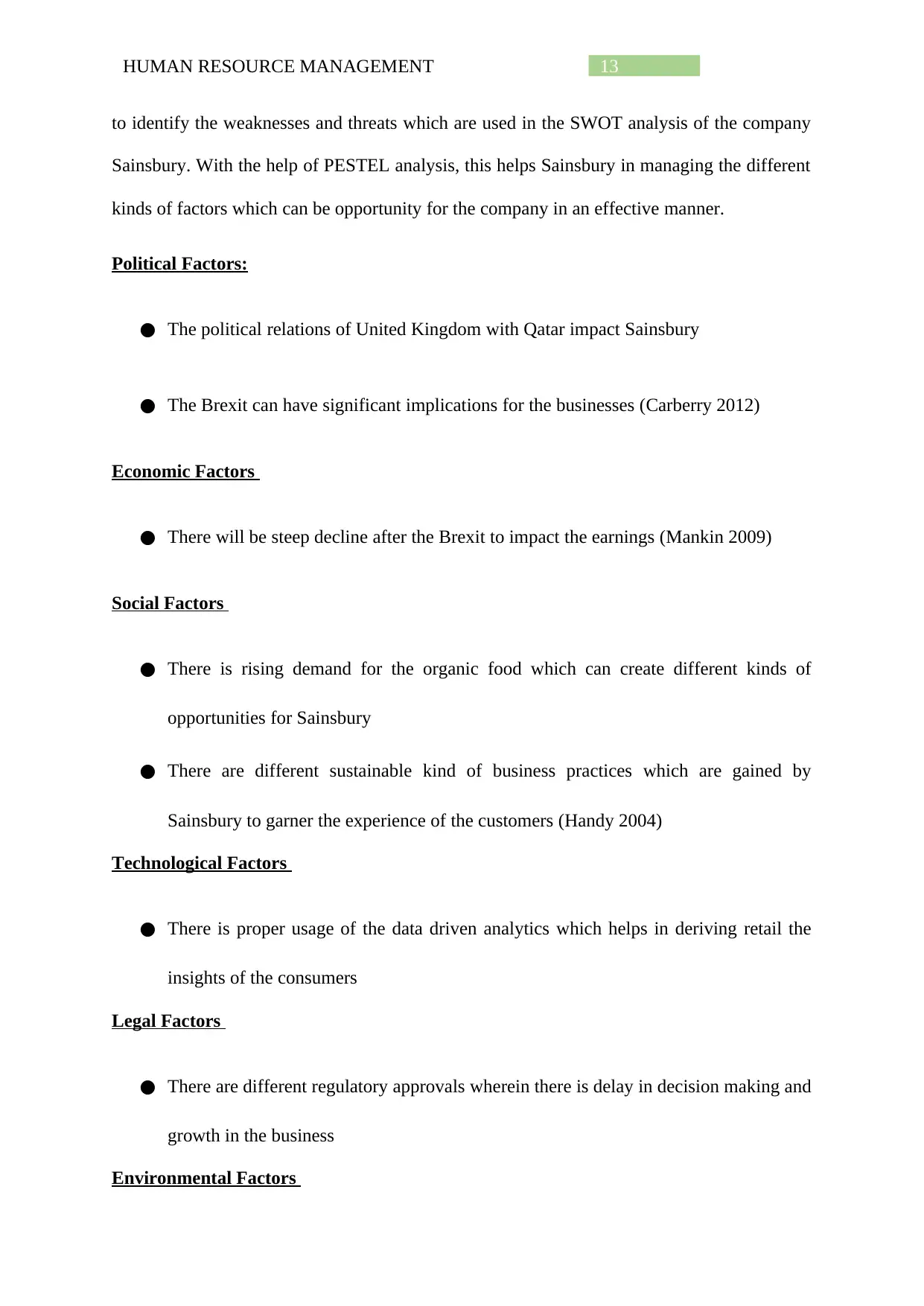
HUMAN RESOURCE MANAGEMENT 13
to identify the weaknesses and threats which are used in the SWOT analysis of the company
Sainsbury. With the help of PESTEL analysis, this helps Sainsbury in managing the different
kinds of factors which can be opportunity for the company in an effective manner.
Political Factors:
● The political relations of United Kingdom with Qatar impact Sainsbury
● The Brexit can have significant implications for the businesses (Carberry 2012)
Economic Factors
● There will be steep decline after the Brexit to impact the earnings (Mankin 2009)
Social Factors
● There is rising demand for the organic food which can create different kinds of
opportunities for Sainsbury
● There are different sustainable kind of business practices which are gained by
Sainsbury to garner the experience of the customers (Handy 2004)
Technological Factors
● There is proper usage of the data driven analytics which helps in deriving retail the
insights of the consumers
Legal Factors
● There are different regulatory approvals wherein there is delay in decision making and
growth in the business
Environmental Factors
to identify the weaknesses and threats which are used in the SWOT analysis of the company
Sainsbury. With the help of PESTEL analysis, this helps Sainsbury in managing the different
kinds of factors which can be opportunity for the company in an effective manner.
Political Factors:
● The political relations of United Kingdom with Qatar impact Sainsbury
● The Brexit can have significant implications for the businesses (Carberry 2012)
Economic Factors
● There will be steep decline after the Brexit to impact the earnings (Mankin 2009)
Social Factors
● There is rising demand for the organic food which can create different kinds of
opportunities for Sainsbury
● There are different sustainable kind of business practices which are gained by
Sainsbury to garner the experience of the customers (Handy 2004)
Technological Factors
● There is proper usage of the data driven analytics which helps in deriving retail the
insights of the consumers
Legal Factors
● There are different regulatory approvals wherein there is delay in decision making and
growth in the business
Environmental Factors
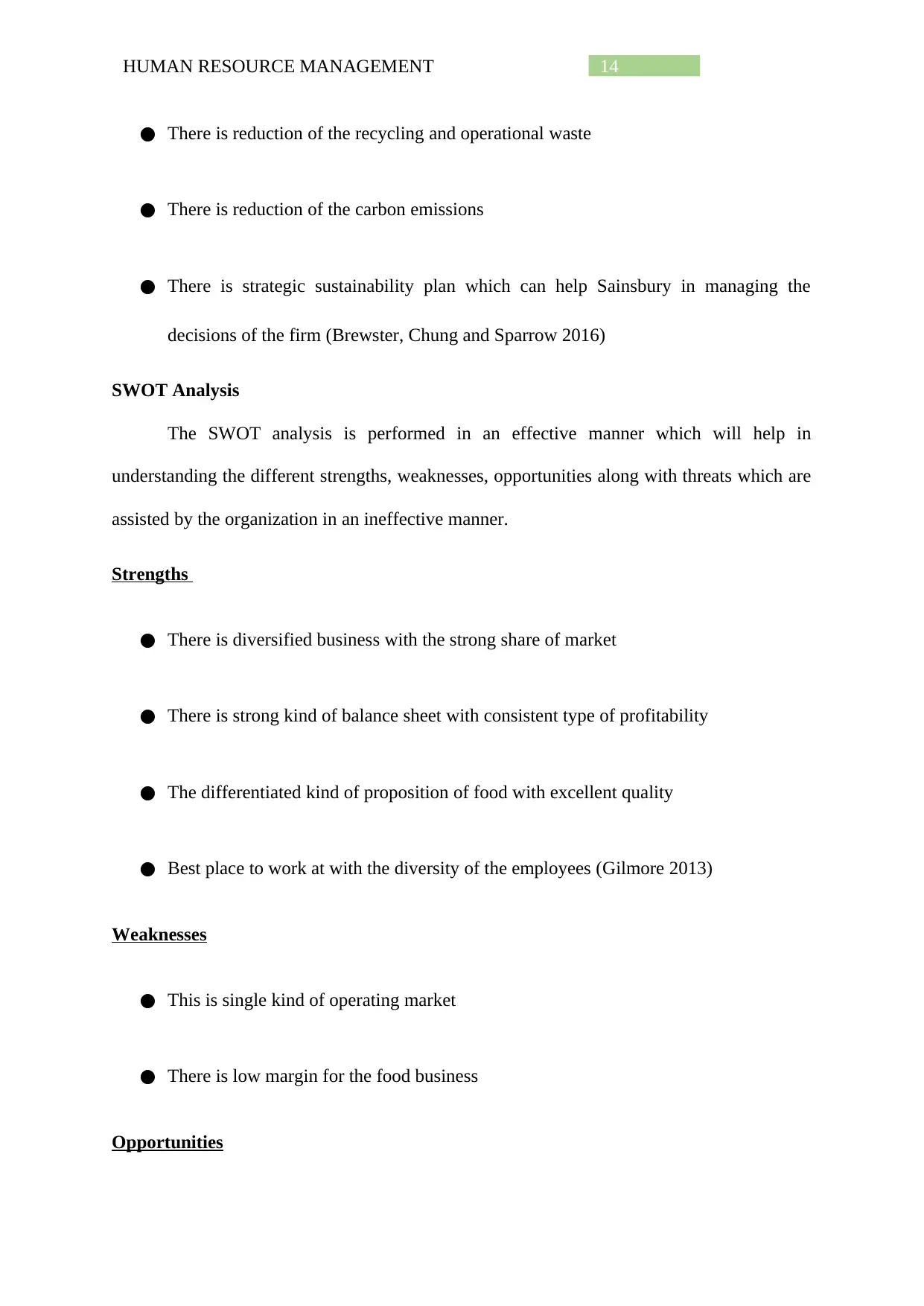
HUMAN RESOURCE MANAGEMENT 14
● There is reduction of the recycling and operational waste
● There is reduction of the carbon emissions
● There is strategic sustainability plan which can help Sainsbury in managing the
decisions of the firm (Brewster, Chung and Sparrow 2016)
SWOT Analysis
The SWOT analysis is performed in an effective manner which will help in
understanding the different strengths, weaknesses, opportunities along with threats which are
assisted by the organization in an ineffective manner.
Strengths
● There is diversified business with the strong share of market
● There is strong kind of balance sheet with consistent type of profitability
● The differentiated kind of proposition of food with excellent quality
● Best place to work at with the diversity of the employees (Gilmore 2013)
Weaknesses
● This is single kind of operating market
● There is low margin for the food business
Opportunities
● There is reduction of the recycling and operational waste
● There is reduction of the carbon emissions
● There is strategic sustainability plan which can help Sainsbury in managing the
decisions of the firm (Brewster, Chung and Sparrow 2016)
SWOT Analysis
The SWOT analysis is performed in an effective manner which will help in
understanding the different strengths, weaknesses, opportunities along with threats which are
assisted by the organization in an ineffective manner.
Strengths
● There is diversified business with the strong share of market
● There is strong kind of balance sheet with consistent type of profitability
● The differentiated kind of proposition of food with excellent quality
● Best place to work at with the diversity of the employees (Gilmore 2013)
Weaknesses
● This is single kind of operating market
● There is low margin for the food business
Opportunities
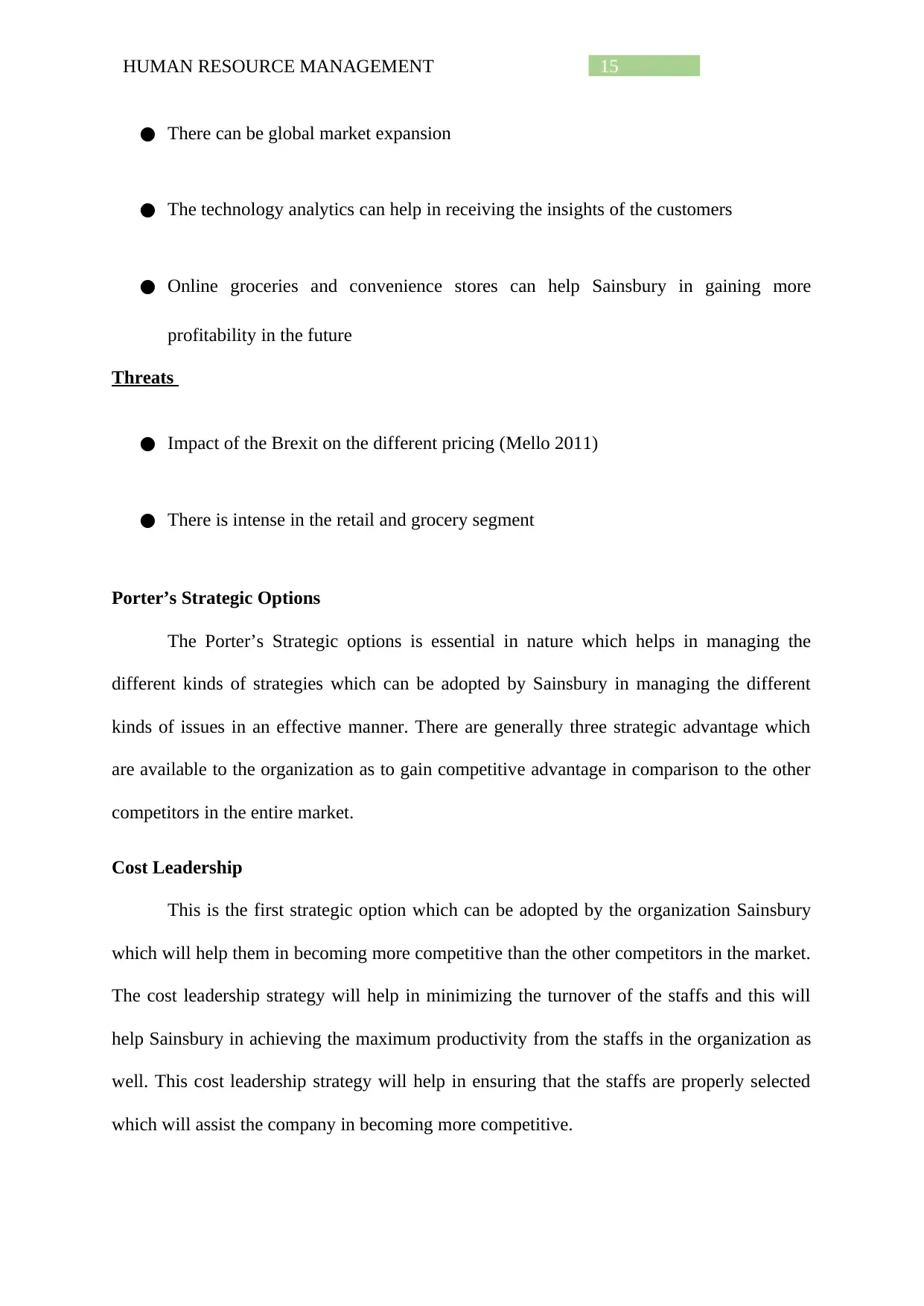
HUMAN RESOURCE MANAGEMENT 15
● There can be global market expansion
● The technology analytics can help in receiving the insights of the customers
● Online groceries and convenience stores can help Sainsbury in gaining more
profitability in the future
Threats
● Impact of the Brexit on the different pricing (Mello 2011)
● There is intense in the retail and grocery segment
Porter’s Strategic Options
The Porter’s Strategic options is essential in nature which helps in managing the
different kinds of strategies which can be adopted by Sainsbury in managing the different
kinds of issues in an effective manner. There are generally three strategic advantage which
are available to the organization as to gain competitive advantage in comparison to the other
competitors in the entire market.
Cost Leadership
This is the first strategic option which can be adopted by the organization Sainsbury
which will help them in becoming more competitive than the other competitors in the market.
The cost leadership strategy will help in minimizing the turnover of the staffs and this will
help Sainsbury in achieving the maximum productivity from the staffs in the organization as
well. This cost leadership strategy will help in ensuring that the staffs are properly selected
which will assist the company in becoming more competitive.
● There can be global market expansion
● The technology analytics can help in receiving the insights of the customers
● Online groceries and convenience stores can help Sainsbury in gaining more
profitability in the future
Threats
● Impact of the Brexit on the different pricing (Mello 2011)
● There is intense in the retail and grocery segment
Porter’s Strategic Options
The Porter’s Strategic options is essential in nature which helps in managing the
different kinds of strategies which can be adopted by Sainsbury in managing the different
kinds of issues in an effective manner. There are generally three strategic advantage which
are available to the organization as to gain competitive advantage in comparison to the other
competitors in the entire market.
Cost Leadership
This is the first strategic option which can be adopted by the organization Sainsbury
which will help them in becoming more competitive than the other competitors in the market.
The cost leadership strategy will help in minimizing the turnover of the staffs and this will
help Sainsbury in achieving the maximum productivity from the staffs in the organization as
well. This cost leadership strategy will help in ensuring that the staffs are properly selected
which will assist the company in becoming more competitive.
Secure Best Marks with AI Grader
Need help grading? Try our AI Grader for instant feedback on your assignments.
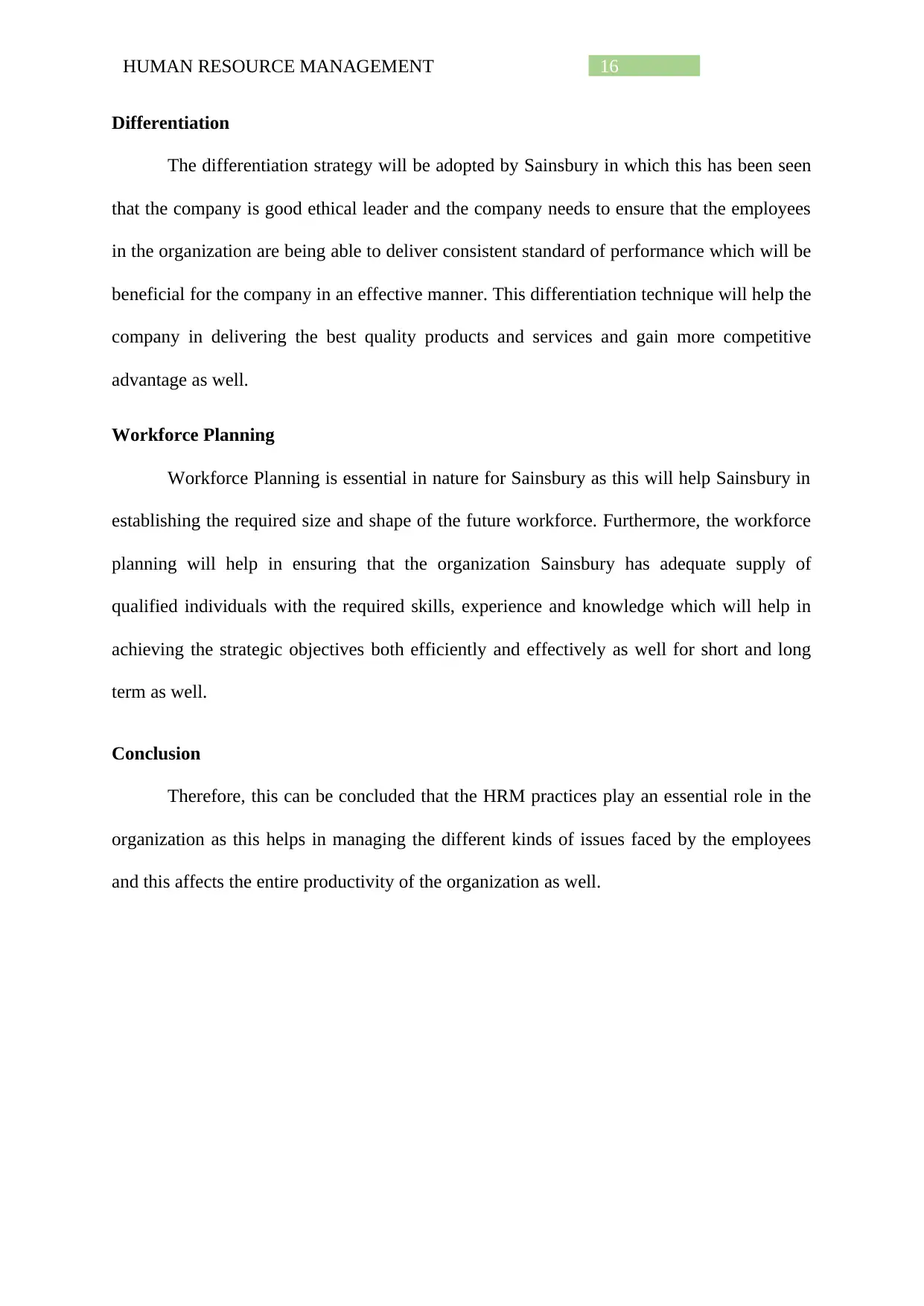
HUMAN RESOURCE MANAGEMENT 16
Differentiation
The differentiation strategy will be adopted by Sainsbury in which this has been seen
that the company is good ethical leader and the company needs to ensure that the employees
in the organization are being able to deliver consistent standard of performance which will be
beneficial for the company in an effective manner. This differentiation technique will help the
company in delivering the best quality products and services and gain more competitive
advantage as well.
Workforce Planning
Workforce Planning is essential in nature for Sainsbury as this will help Sainsbury in
establishing the required size and shape of the future workforce. Furthermore, the workforce
planning will help in ensuring that the organization Sainsbury has adequate supply of
qualified individuals with the required skills, experience and knowledge which will help in
achieving the strategic objectives both efficiently and effectively as well for short and long
term as well.
Conclusion
Therefore, this can be concluded that the HRM practices play an essential role in the
organization as this helps in managing the different kinds of issues faced by the employees
and this affects the entire productivity of the organization as well.
Differentiation
The differentiation strategy will be adopted by Sainsbury in which this has been seen
that the company is good ethical leader and the company needs to ensure that the employees
in the organization are being able to deliver consistent standard of performance which will be
beneficial for the company in an effective manner. This differentiation technique will help the
company in delivering the best quality products and services and gain more competitive
advantage as well.
Workforce Planning
Workforce Planning is essential in nature for Sainsbury as this will help Sainsbury in
establishing the required size and shape of the future workforce. Furthermore, the workforce
planning will help in ensuring that the organization Sainsbury has adequate supply of
qualified individuals with the required skills, experience and knowledge which will help in
achieving the strategic objectives both efficiently and effectively as well for short and long
term as well.
Conclusion
Therefore, this can be concluded that the HRM practices play an essential role in the
organization as this helps in managing the different kinds of issues faced by the employees
and this affects the entire productivity of the organization as well.
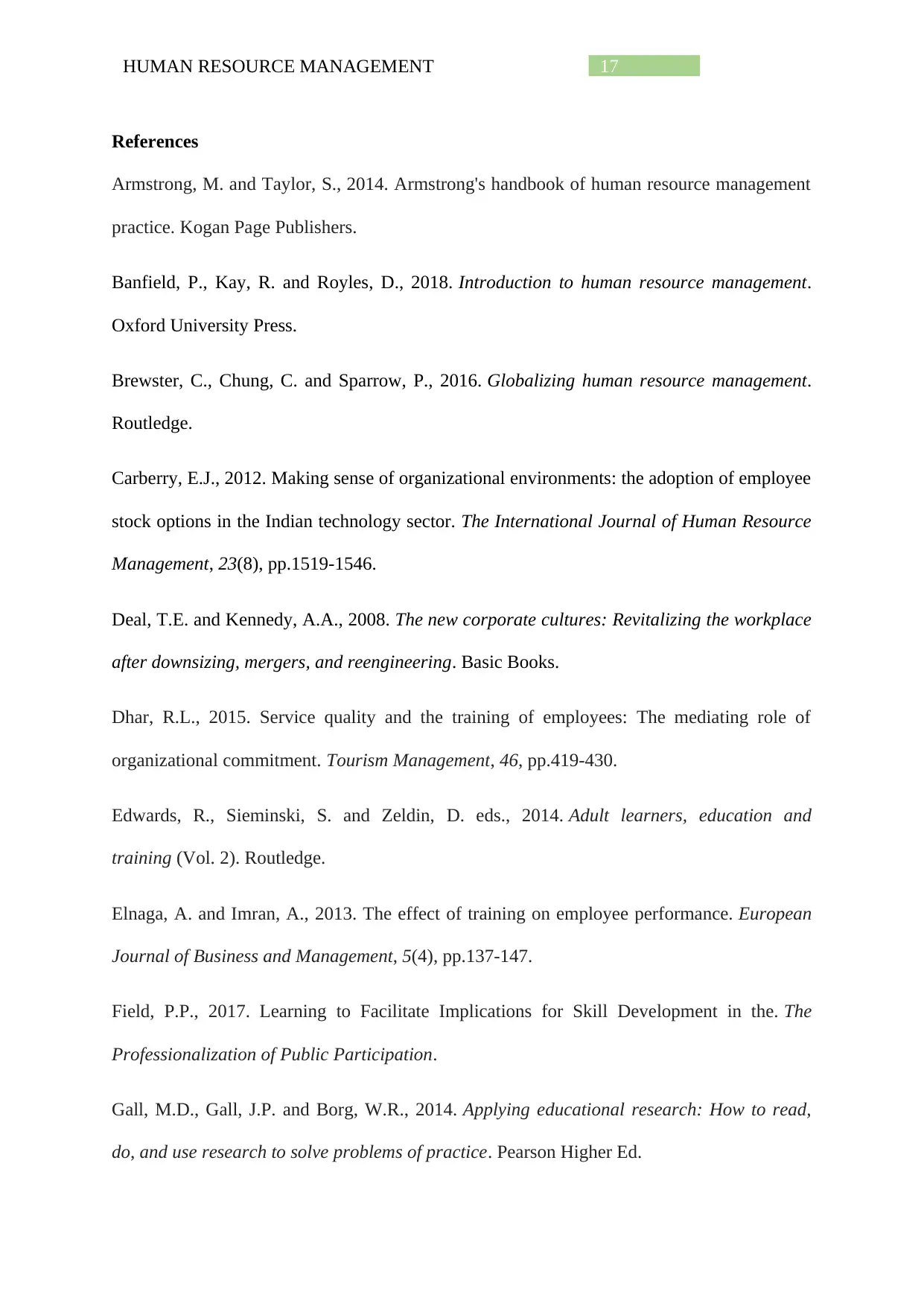
HUMAN RESOURCE MANAGEMENT 17
References
Armstrong, M. and Taylor, S., 2014. Armstrong's handbook of human resource management
practice. Kogan Page Publishers.
Banfield, P., Kay, R. and Royles, D., 2018. Introduction to human resource management.
Oxford University Press.
Brewster, C., Chung, C. and Sparrow, P., 2016. Globalizing human resource management.
Routledge.
Carberry, E.J., 2012. Making sense of organizational environments: the adoption of employee
stock options in the Indian technology sector. The International Journal of Human Resource
Management, 23(8), pp.1519-1546.
Deal, T.E. and Kennedy, A.A., 2008. The new corporate cultures: Revitalizing the workplace
after downsizing, mergers, and reengineering. Basic Books.
Dhar, R.L., 2015. Service quality and the training of employees: The mediating role of
organizational commitment. Tourism Management, 46, pp.419-430.
Edwards, R., Sieminski, S. and Zeldin, D. eds., 2014. Adult learners, education and
training (Vol. 2). Routledge.
Elnaga, A. and Imran, A., 2013. The effect of training on employee performance. European
Journal of Business and Management, 5(4), pp.137-147.
Field, P.P., 2017. Learning to Facilitate Implications for Skill Development in the. The
Professionalization of Public Participation.
Gall, M.D., Gall, J.P. and Borg, W.R., 2014. Applying educational research: How to read,
do, and use research to solve problems of practice. Pearson Higher Ed.
References
Armstrong, M. and Taylor, S., 2014. Armstrong's handbook of human resource management
practice. Kogan Page Publishers.
Banfield, P., Kay, R. and Royles, D., 2018. Introduction to human resource management.
Oxford University Press.
Brewster, C., Chung, C. and Sparrow, P., 2016. Globalizing human resource management.
Routledge.
Carberry, E.J., 2012. Making sense of organizational environments: the adoption of employee
stock options in the Indian technology sector. The International Journal of Human Resource
Management, 23(8), pp.1519-1546.
Deal, T.E. and Kennedy, A.A., 2008. The new corporate cultures: Revitalizing the workplace
after downsizing, mergers, and reengineering. Basic Books.
Dhar, R.L., 2015. Service quality and the training of employees: The mediating role of
organizational commitment. Tourism Management, 46, pp.419-430.
Edwards, R., Sieminski, S. and Zeldin, D. eds., 2014. Adult learners, education and
training (Vol. 2). Routledge.
Elnaga, A. and Imran, A., 2013. The effect of training on employee performance. European
Journal of Business and Management, 5(4), pp.137-147.
Field, P.P., 2017. Learning to Facilitate Implications for Skill Development in the. The
Professionalization of Public Participation.
Gall, M.D., Gall, J.P. and Borg, W.R., 2014. Applying educational research: How to read,
do, and use research to solve problems of practice. Pearson Higher Ed.
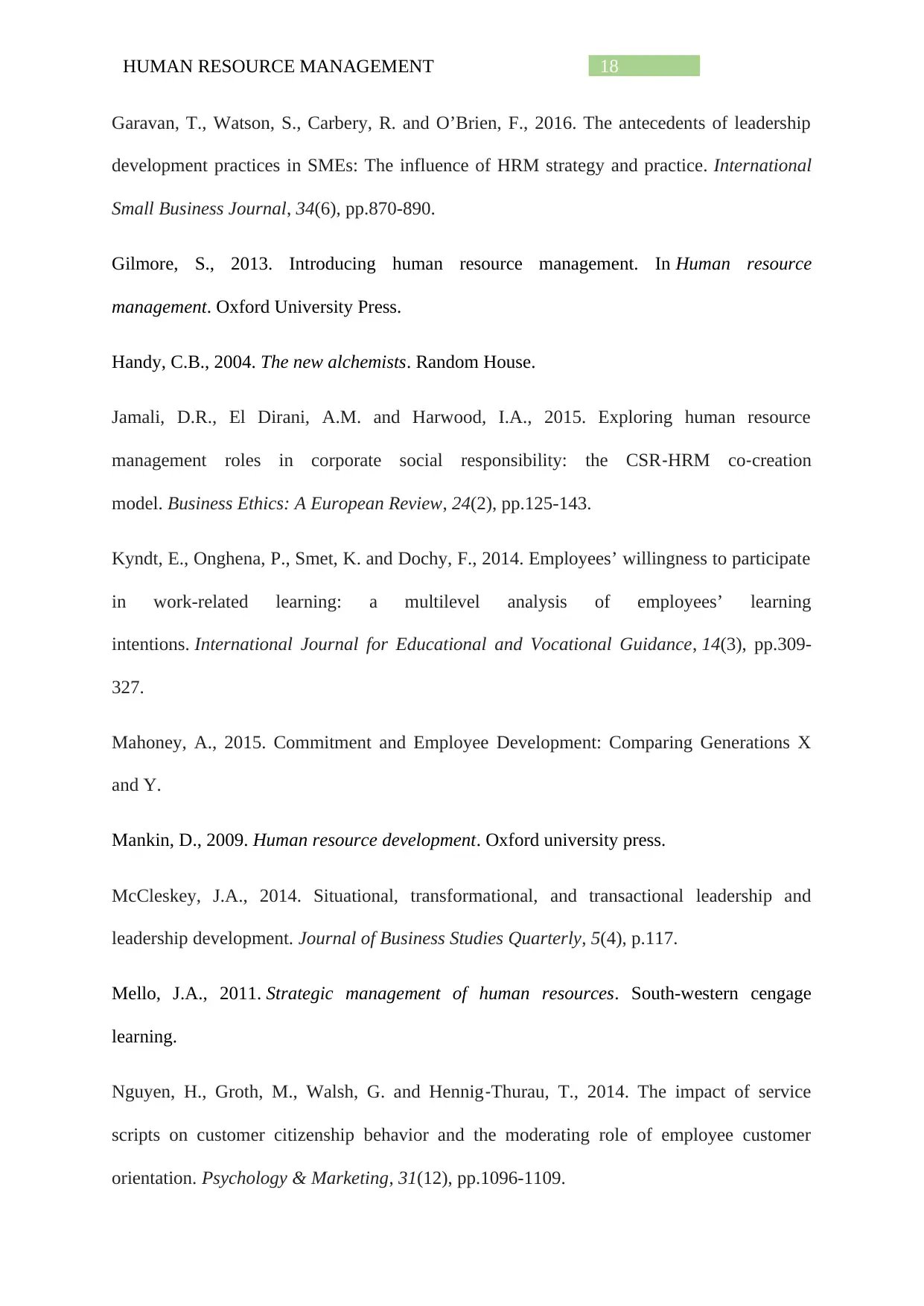
HUMAN RESOURCE MANAGEMENT 18
Garavan, T., Watson, S., Carbery, R. and O’Brien, F., 2016. The antecedents of leadership
development practices in SMEs: The influence of HRM strategy and practice. International
Small Business Journal, 34(6), pp.870-890.
Gilmore, S., 2013. Introducing human resource management. In Human resource
management. Oxford University Press.
Handy, C.B., 2004. The new alchemists. Random House.
Jamali, D.R., El Dirani, A.M. and Harwood, I.A., 2015. Exploring human resource
management roles in corporate social responsibility: the CSR‐HRM co‐creation
model. Business Ethics: A European Review, 24(2), pp.125-143.
Kyndt, E., Onghena, P., Smet, K. and Dochy, F., 2014. Employees’ willingness to participate
in work-related learning: a multilevel analysis of employees’ learning
intentions. International Journal for Educational and Vocational Guidance, 14(3), pp.309-
327.
Mahoney, A., 2015. Commitment and Employee Development: Comparing Generations X
and Y.
Mankin, D., 2009. Human resource development. Oxford university press.
McCleskey, J.A., 2014. Situational, transformational, and transactional leadership and
leadership development. Journal of Business Studies Quarterly, 5(4), p.117.
Mello, J.A., 2011. Strategic management of human resources. South-western cengage
learning.
Nguyen, H., Groth, M., Walsh, G. and Hennig‐Thurau, T., 2014. The impact of service
scripts on customer citizenship behavior and the moderating role of employee customer
orientation. Psychology & Marketing, 31(12), pp.1096-1109.
Garavan, T., Watson, S., Carbery, R. and O’Brien, F., 2016. The antecedents of leadership
development practices in SMEs: The influence of HRM strategy and practice. International
Small Business Journal, 34(6), pp.870-890.
Gilmore, S., 2013. Introducing human resource management. In Human resource
management. Oxford University Press.
Handy, C.B., 2004. The new alchemists. Random House.
Jamali, D.R., El Dirani, A.M. and Harwood, I.A., 2015. Exploring human resource
management roles in corporate social responsibility: the CSR‐HRM co‐creation
model. Business Ethics: A European Review, 24(2), pp.125-143.
Kyndt, E., Onghena, P., Smet, K. and Dochy, F., 2014. Employees’ willingness to participate
in work-related learning: a multilevel analysis of employees’ learning
intentions. International Journal for Educational and Vocational Guidance, 14(3), pp.309-
327.
Mahoney, A., 2015. Commitment and Employee Development: Comparing Generations X
and Y.
Mankin, D., 2009. Human resource development. Oxford university press.
McCleskey, J.A., 2014. Situational, transformational, and transactional leadership and
leadership development. Journal of Business Studies Quarterly, 5(4), p.117.
Mello, J.A., 2011. Strategic management of human resources. South-western cengage
learning.
Nguyen, H., Groth, M., Walsh, G. and Hennig‐Thurau, T., 2014. The impact of service
scripts on customer citizenship behavior and the moderating role of employee customer
orientation. Psychology & Marketing, 31(12), pp.1096-1109.
Paraphrase This Document
Need a fresh take? Get an instant paraphrase of this document with our AI Paraphraser
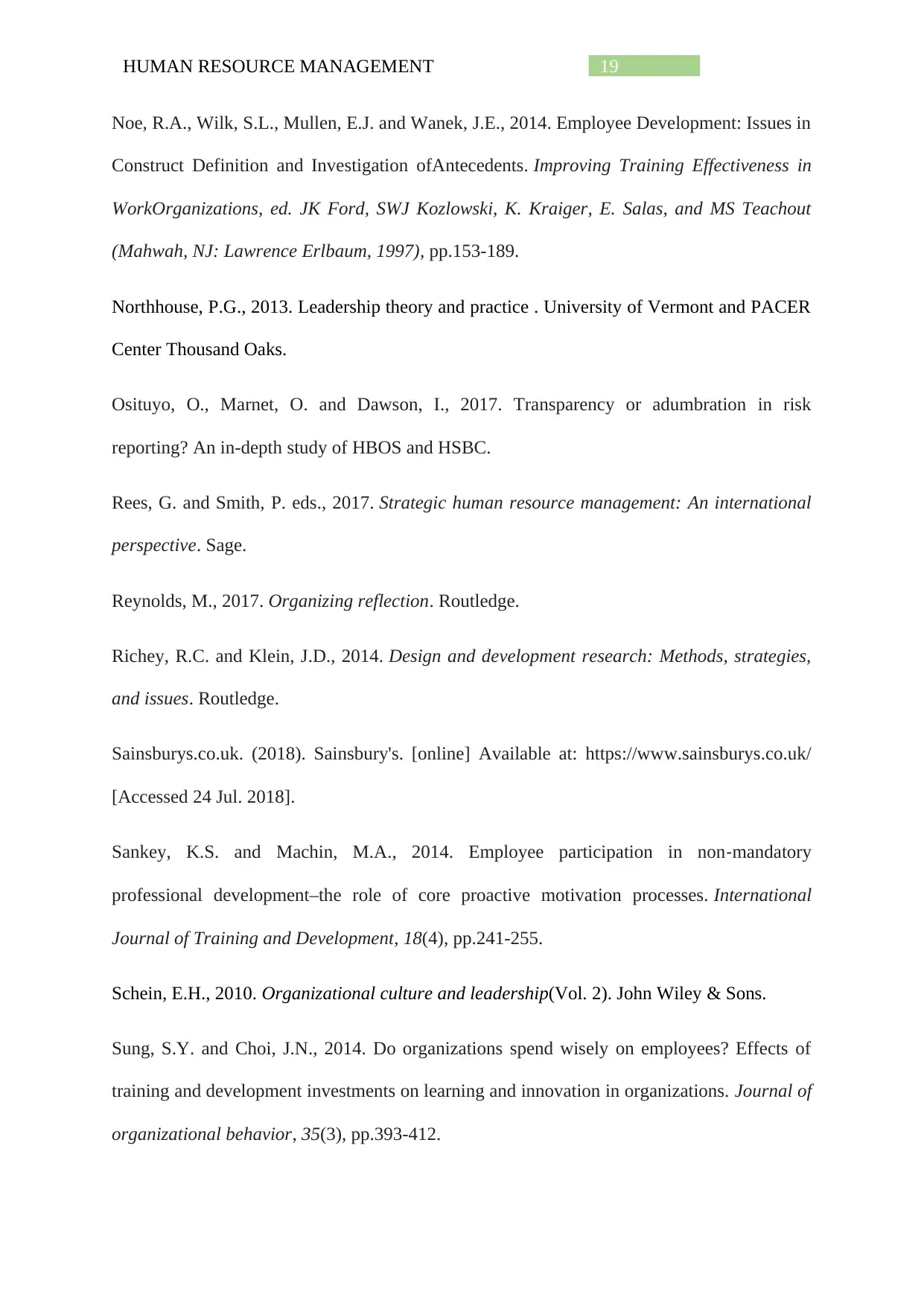
HUMAN RESOURCE MANAGEMENT 19
Noe, R.A., Wilk, S.L., Mullen, E.J. and Wanek, J.E., 2014. Employee Development: Issues in
Construct Definition and Investigation ofAntecedents. Improving Training Effectiveness in
WorkOrganizations, ed. JK Ford, SWJ Kozlowski, K. Kraiger, E. Salas, and MS Teachout
(Mahwah, NJ: Lawrence Erlbaum, 1997), pp.153-189.
Northhouse, P.G., 2013. Leadership theory and practice . University of Vermont and PACER
Center Thousand Oaks.
Osituyo, O., Marnet, O. and Dawson, I., 2017. Transparency or adumbration in risk
reporting? An in-depth study of HBOS and HSBC.
Rees, G. and Smith, P. eds., 2017. Strategic human resource management: An international
perspective. Sage.
Reynolds, M., 2017. Organizing reflection. Routledge.
Richey, R.C. and Klein, J.D., 2014. Design and development research: Methods, strategies,
and issues. Routledge.
Sainsburys.co.uk. (2018). Sainsbury's. [online] Available at: https://www.sainsburys.co.uk/
[Accessed 24 Jul. 2018].
Sankey, K.S. and Machin, M.A., 2014. Employee participation in non‐mandatory
professional development–the role of core proactive motivation processes. International
Journal of Training and Development, 18(4), pp.241-255.
Schein, E.H., 2010. Organizational culture and leadership(Vol. 2). John Wiley & Sons.
Sung, S.Y. and Choi, J.N., 2014. Do organizations spend wisely on employees? Effects of
training and development investments on learning and innovation in organizations. Journal of
organizational behavior, 35(3), pp.393-412.
Noe, R.A., Wilk, S.L., Mullen, E.J. and Wanek, J.E., 2014. Employee Development: Issues in
Construct Definition and Investigation ofAntecedents. Improving Training Effectiveness in
WorkOrganizations, ed. JK Ford, SWJ Kozlowski, K. Kraiger, E. Salas, and MS Teachout
(Mahwah, NJ: Lawrence Erlbaum, 1997), pp.153-189.
Northhouse, P.G., 2013. Leadership theory and practice . University of Vermont and PACER
Center Thousand Oaks.
Osituyo, O., Marnet, O. and Dawson, I., 2017. Transparency or adumbration in risk
reporting? An in-depth study of HBOS and HSBC.
Rees, G. and Smith, P. eds., 2017. Strategic human resource management: An international
perspective. Sage.
Reynolds, M., 2017. Organizing reflection. Routledge.
Richey, R.C. and Klein, J.D., 2014. Design and development research: Methods, strategies,
and issues. Routledge.
Sainsburys.co.uk. (2018). Sainsbury's. [online] Available at: https://www.sainsburys.co.uk/
[Accessed 24 Jul. 2018].
Sankey, K.S. and Machin, M.A., 2014. Employee participation in non‐mandatory
professional development–the role of core proactive motivation processes. International
Journal of Training and Development, 18(4), pp.241-255.
Schein, E.H., 2010. Organizational culture and leadership(Vol. 2). John Wiley & Sons.
Sung, S.Y. and Choi, J.N., 2014. Do organizations spend wisely on employees? Effects of
training and development investments on learning and innovation in organizations. Journal of
organizational behavior, 35(3), pp.393-412.
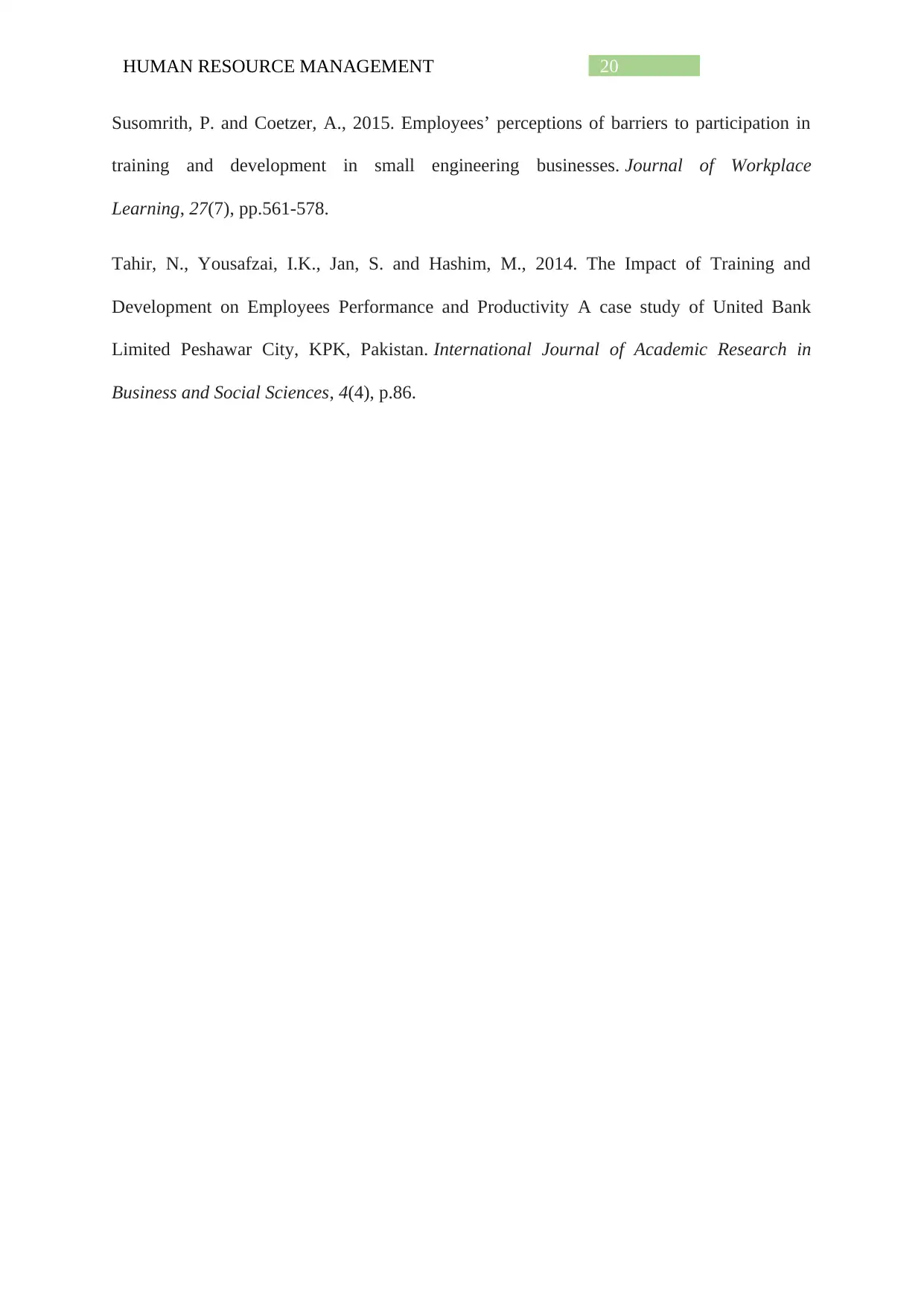
HUMAN RESOURCE MANAGEMENT 20
Susomrith, P. and Coetzer, A., 2015. Employees’ perceptions of barriers to participation in
training and development in small engineering businesses. Journal of Workplace
Learning, 27(7), pp.561-578.
Tahir, N., Yousafzai, I.K., Jan, S. and Hashim, M., 2014. The Impact of Training and
Development on Employees Performance and Productivity A case study of United Bank
Limited Peshawar City, KPK, Pakistan. International Journal of Academic Research in
Business and Social Sciences, 4(4), p.86.
Susomrith, P. and Coetzer, A., 2015. Employees’ perceptions of barriers to participation in
training and development in small engineering businesses. Journal of Workplace
Learning, 27(7), pp.561-578.
Tahir, N., Yousafzai, I.K., Jan, S. and Hashim, M., 2014. The Impact of Training and
Development on Employees Performance and Productivity A case study of United Bank
Limited Peshawar City, KPK, Pakistan. International Journal of Academic Research in
Business and Social Sciences, 4(4), p.86.
1 out of 21
Related Documents
Your All-in-One AI-Powered Toolkit for Academic Success.
+13062052269
info@desklib.com
Available 24*7 on WhatsApp / Email
![[object Object]](/_next/static/media/star-bottom.7253800d.svg)
Unlock your academic potential
© 2024 | Zucol Services PVT LTD | All rights reserved.





